« November 2005 | Main | January 2006 »
December 29, 2005
Blogging the gifs away

Hypertemporality Animations
Hypertemporality Animations, a project by Peter Baldes, are a series of gif files laid out in a table that due to network conditions, browser idiosyncrasies, and the user’s own behaviour act dynamically. These simple, animated shapes and colors load sequencially, a typical web browser behaviour, giving birth to dynamic images that are the result of factors other than the artist's will. Reloading them or using different browsers will make them load differently everytime. Slower or faster Internet connection speed will influence how the animations are viewed.
These Hypertemps are categorized according to three subjects: color field, shape and web, which are simply a way to catalogue the artist’s inspiration for the original animated composition. Web relates to the use of an already existing animated gif. In the case of the flickr ones, Baldes created his own from a known web image (the flickr loading screen interface animation). Web also relates to representing time. Cory Arcangel's email gif gets subverted to more accurately show what an email must go through to arrive at it's destination, Tom Moody's atomic animation is broken down to show Heisenberg's uncertainty principle, flickr loads slowly… Animations labelled as color field use specific colour palettes or colour relationships that are significantly interesting to the artist. Shape follows the same principle than the previous category but now taking forms and shapes as the main interest.
These animations were originally created for an online exhibition called Hypertemportality, hosted by the University of Richmond and curated by Nathan Altice. Now they have moved to a blog, allowing Baldes to explore a more dynamic, almost performative way of creating and presenting his animated experiments.
Hypertemporality Animations
2005 - ongoing
Peter Baldes
http://hypertemps.procurate.com/
Posted by luis at 10:34 AM | Comments (0)
December 18, 2005
Silence of the Lands
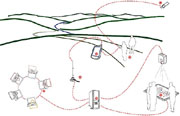
Shared Individual and Collective Sound Cartographies
Silence of the Lands enables participants to collect ambient sounds, then to create and share individual and collective cartographies. These sounds represent subjective interpretations of the soundscape of the urban or natural settings that affect the everyday life of the community, and act as conversation pieces about natural quiet.
1. Data catching: ambient sounds are collected using a PDA. The sounds are linked to the person that collected them, and associated to GPS data; 2. Data description: the sounds are then stored in a database, visualized on a GIS map, and made available for audio-streaming in the web community as individual soundscapes. Participants can access, manage, and eventually modify their own individual soundscapes, associating to them several descriptors; 3. Data interpretation: participants can interact with the collective soundscape. By playing with physical objects in an interactive environment, participants are encouraged to interpret the collective soundscape and create an idealized, virtual one.
A project by Elisa Giaccardi in collaboration with Gianluca Sabena, Hal Eden, and Gruppo Sfera. Currently under development at the Center for LifeLong Learning & Design, University of Colorado, Boulder. Related: Streetscape. [blogged by Regine on we-make-money-not-art]
Posted by jo at 05:57 PM | Comments (0)
Counter-Surveillance Headdress
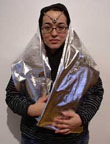
Become a Target of Heightened Surveillance
The purpose of the Counter-Surveillance Headdress, by Gloria Sed, is to empower the wearer by allowing him/her to claim a moment of privacy in the Big Brother world.
The design of the headdress borrows from Islamic and Hindu fashion to comment on the racial profiling of Arab and Arab-looking citizens that occurred post-9/11. The design of the headdress is thus a contradiction: while its goal is to hide the wearer, it makes the wearer a target of heightened surveillance.
The laser tikka (forehead ornament) is attached to a hooded vest and reflective shawl. The laser is activated by pressing a button on the left shoulder of the vest. When pointed directly into a camera lens, the laser creates a burst of light masking the wearer’s face. The wearer can also use the reflective cloth to cover the face and head. The aluminized material protects her/him by reflecting any infrared radiation and also disguises the wearer by visually reflecting the surroundings, rendering the wearer’s identity anonymous. For more information on camera zapping with lasers. At the itp Winter Show, on December 18 and 19, ITP, 721 Broadway at Waverly Place, 4th Floor, South Elevators, New York. [blogged by Regine on we-make-money-not-art]
Posted by jo at 01:10 PM | Comments (0)
December 16, 2005
The Eyeborg

Hearing a Colour Wheel
Neil Harbisson is, quite literally, a man who has always viewed life in black and white. The 22-year-old Spaniard, who moved to Totnes in south Devon in 2003, was born with achromatopsia, a rare condition that affects only one person in 33,000 and causes monochromatism, or complete colour blindness.
But last year, he was able to see – or, more accurately, hear – colours for the first time. Neil has been fitted with a machine that turns colours into soundwaves, with a different sound representing each hue. The Eye-Borg, as it is known, features a head-mounted digital camera that reads the colours in front of Neil and converts them into sound. A scale of musical tones represents the spectrum of colours – light hues are high-pitched, while darker colours sound bolder. It is, in a way, forced synaesthesia; its creator, 24-year-old digital multimedia expert Adam Montandon, describes the invention as "like hearing a colour wheel".
Posted by jo at 03:41 PM | Comments (0)
Lacuna
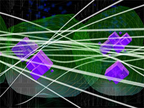
In the 'gap' Between Physical and Electronic Volume
Lacuna is a response to the relationship between body and architecture in the cyborg era. Existing in the perceived 'gap' between physical volume and electronic volume, Lacuna is customised software that communicates between the visual medium of the screen and a high resolution electronic skin of real world architecture. This in turn creates virtual counterpart architecture, enhancing the electronic Cybrid dimension of construction.
Lacuna--by HMC MediaLab--is a new architectural experiment that allows physical architecture to extend itself into the realm of zero physicality to become a Hyperflexible Space. Movement, temperature, gasses, wind, sound, data, water usage, electrical information, fans, and lift position are among a few of the hundreds of sensors used to alter the Lacuna software in real-time, allowing a unique representation of the building not in traditional space and time or virtual electronic space, but somewhere between the two.
Visitors to Plymouth's unique Portland Square building interact not through the key-press, or mouse-click associated with computing, but their very presence, or lack of presence, and usage of the building is converted into electronic signals. This, for the first time, allows visitors to exist simultaneously in the real and the virtual, they are everywhere and nowhere. Lacuna is in a constant state of flux, and intelligently updates, modifies and mutates itself many times a second.
Posted by jo at 03:37 PM | Comments (0)
Audio Visual Orchestra
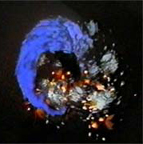
Hallunication, Synaesthesia and Technology
The Audio Visual Orchestra--an HMC MediaLab project--explores the relationship between hallucination and technology, between the natural and the artificial and between the everyday and the mystical. It recreates an altered state of consciousness in the viewer solely through technological means. It is fractaline, chaotic and self-organising in form. These pieces represent a shared space between the physical and the virtual, the brain and the mind.
The Audio Visual Orchestra brings together dancers, musicians and video artists, working to create stunning live art pieces, with an emphasis on combining the spiritual with the technological, culminating in artworks that will react dynamically to your presence. As you stand in the space huge screens show an image of you with colours and shapes flying around your body. The visuals are complimented by strange echoing sounds that react to any noise you make. The sounds and the visuals can be intrinsically linked creating a true synaesthesia.
Posted by jo at 03:30 PM | Comments (0)
Adam Greenfield
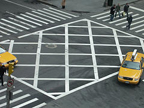
Ubicomp/Everyware
"I've seen a great deal of techno-optimism and even -utopianism around ubicomp, including a fair amount from people who should know better. But despite a deep folk understanding of some of the risks involved - Philip K. Dick was writing stories featuring recalcitrant doors and dilatory automated taxis in the late 1950s, and we've all heard of HAL9000 - there hasn't really been much in the way of people pushing back against the idea of ubicomp, in a measured and knowledgeable way. And so I've started to make some noise about what I see coming down the road, describing the reality I see lurking behind the marketing hype that's already beginning to build about the ostensible "conveniences" that await us."-Adam Greenfield interview on Studies and Observations.
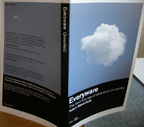
Everyware: The Dawning Age of Ubiquitous Computing by Adam Greenfield:
From the RFID tags now embedded in everything from soda cans to the family pet, to smart buildings that subtly adapt to the changing flow of visitors, to gestural interfaces like the ones seen in Minority Report, computing no longer looks much like it used to. Increasingly invisible but present everywhere in our lives, it has moved off the desktop and out into everyday life–affecting almost every one of us, whether we're entirely aware of it or not.
Author Adam Greenfield calls this ubiquitous computing "everyware." In a uniquely engaging approach to this complex topic, Greenfield explains how such "information processing dissolving in behavior" is reshaping our lives; brief, aphoristic chapters explore the technologies, practices, and innovations that make everyware so powerful and seem so inevitable.
If you've ever sensed both the promise of the next computing, and the challenges it represents for all of us, this is the book for you. "Everyware" aims to gives its reader the tools to understand the next computing, and make the kind of wise decisions that will shape its emergence in ways that support the best that is in us.
Adam Greenfield is principal of the New York City-based design consultancy Studies and Observations. He was previously lead information architect for the Tokyo office of Razorfish. His personal Web site, v-2.org, was nominated for a Chrysler Design Award in 2000.
[via Interactive Architecture dot org]
Posted by jo at 03:14 PM | Comments (0)
D>Art.06
![]()
Condition of Emergence
D>Art.06 is the ninth edition of Australia's premier screen and digital media arts festival. This year's festival will feature new and experimental video and web art as well as works using mobile technologies presented in a month-long program of screenings, a forum and an exhibition at the Sydney Opera House Studio and Exhibition Hall in April 2006.
Under the theme Condition of Emergence, dLux media arts is now calling for works in the following categories of D>Art.06: D>Art.06 Screen: Experimental video works with a maximum duration of 15 minutes; D>Art.06 Web: Online works suitable for exhibition in a gallery environment; D>Art.06 Locative/Mobile: Artworks specifically made with or for mobile technologies. The nature of the artwork may range from video to games to locative and social networking applications.
All works submitted must have been completed in 2005 or 2006.
The call for entries closes on February 18th 2006. Any entries not received by this date will not be accepted.
For more information, detailed entry conditions and to submit your work to D>Art.06, please visit http://www.dlux.org.au/dart06
Posted by jo at 12:23 PM | Comments (0)
NEURAL n.23
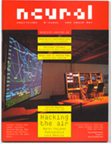
new.media.art, e.music, hacktivism
The new printed Neural issue in English is available: Neural n.23:
new.media.art . interviews Tom Betts/Nullpointer . Socialfiction.org . //////////fur/// . Paper and Pixel . news (Flickr Peep Show, PostSecret, Sequences, Mindbending, inc., Silver Cell). reviews (Art meets Media, Aspect, Internet Art, Situated Contemporary Art Practices, read_me, Digital Homo Ludens, Feelings are always local) . centerfold: Movement of Movements.
e.music . interviews. Radioqualia. Janek Schaefer . Circuit Bending . news: (FontanaMixer, The Unauthorized iPod, MIDIbox SID, The Continuator, MPF) . reviews: (Hexstatic, Robin Fox, Akuvido, Steinbruchel, Thomas Brusa, The Dawn of DIMI) . reviews cd: (Christian Marclay, Musica Futurista, Phon.o, Si-cut.Db, Agents of Impurity, Koji Asano, Oh Astro, Transient Travels, PXP, Kiritchenko, JDS, Forbidden 80s, Electric Lounge Orchestra, Noise Tank, Pirandelo...)
hacktivism . interviews . Marko Peljhan . McKenzie Wark . Luca Bertini . news (Our Beer, Scream, TV Predator, Wordnews, The International Database of Corporate Commands). reviews: (Information Politcs on the Web, At a Distance, Make Magazine, Hackers and Painters, We the Media).
1 YEAR SUBSCRIPTION!
3 issues + 1 electronic music cd
Europe 24,90 euro.
World 33,32 U.S: Dollars.
http://neural.it/subscribe/
NEURAL http://english.neural.it/
Posted by jo at 09:24 AM | Comments (0)
December 15, 2005
The Rules are no Game
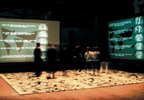
The Dance of Dripping: Auto-Generating Text
The Rules are no Game [MAOD] by Markus Huemer: The ZKM/Center of Art and Mediatechnologie will house a networked installation based upon Jackson Pollock’s image »No.32«. The floor of the area is covered with a reproduction of Pollock’s said picture as a reference to »The Dance of Dripping« and to »All Over«. Two text projections with auto-generating sentences are randomly projected on two screens. The visitors are both receptors and producers of the projected texts. In order to read the text, the audience will move to and fro, triggering an Internet-mechanism through the sheer act of walking on Pollock’s picture. It is this mechanism that generates the text, and each visitor’s movement will lead to the generation of a new line of text. Additionally, when the visitors approach one of the projections in order to read the texts, the sentences will be generated on the second projection. Thus the two projections communicate with each other and the visitors, paraphrasing the relative positions of the visitors within the exhibition space from a point-of-view that is situated on the Net, i.e., outside the exhibition.
All generated texts will use the subjunctive mode (conjunctivus irrealis and potentialis) and the texts are accessible on the Net via any Internet gateway. What results is an inversion of the »classical« exhibition situation–here, Art watches the audience and reacts to their actions with a continuous transformation of its self. By their movement in the space, the visitors will revive the »Dance of Dripping« on the »prefabricated« Action Painting by Pollock, their actions being monitored and »interpreted« by the Net generating the textual response. Through this immersion into the »virtual outside« the visitors will lose their status as subjects and become the objects of a description by the Net. [via Regine on we-make-money-not-art] [Related]
Posted by jo at 04:46 PM | Comments (0)
TURBULENCE NEEDS YOUR SUPPORT
2005 Fundraiser
Art donated by Cory Arcangel, Kate Armstrong, Andy Deck, Jason Freeman, Mariam Ghani, Peter Horvath, Yael Kanarek, Michael Takeo Magruder, Michael Mandiberg, MTAA, Yoshi Sodeoka, Nathaniel Stern, Helen Thorington and Ricardo Miranda Zuñiga.
Dear Friends,
New Radio and Performing Arts, Inc. (NRPA) will be 25 years old in 2006; Turbulence will be 10 years old. Despite the expansion of our projects, the acceleration of our support for net artists, and the valuable resources we provide in our networked_performance blog and New American Radio archive, NRPA has seen a decline in its operating support. As a result, much of our hard work forgoes compensation. Of equal concern is the dual role our server is forced to perform: archiving work produced since 1996 and supporting new commissions that require cutting edge technologies and later versions of its current software. It's time for a new server!
We need your support. Please help us preserve our archives and support emerging artists and technologies. Numerous Turbulence artists have generously donated DVDs, CDs, archival prints, T-Shirts and more. Choose from this impressive array or simply make a donation today.
With Gratitude,
Helen Thorington and Jo-Anne Green
Co-Directors
Posted by jo at 01:30 PM | Comments (0)
DriftNet
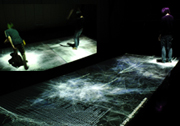
Surfing Data Waves
When I think about the word "NetSurfing", I found that we are net surfer(s) who can't swim. In a different word, we are never free on the net without browser ready-made surf board.
In the DriftNet installation, users interact with a data-wave by using their body like they would on a real beach. "DriftNet" connects to the World Wide Web. The first website DriftNet accesses is chosen depending on the location of the exhibition site. The data is displayed in hexadecimal format [on the floor] without encoding. The screen shot of the website covers the surface of the wave, is decomposed into an abstract color element and generates unlimited variations of wave appearances. Movements of the audience are analyzed and conveyed to the wave as the vector of the plural forces with location, direction and integer value.
When the wave is moved fast, the link from the URL which generated the wave comes to the surface. After some time, the wave of the first link fades out and "DriftNet" chooses the next URL (the one which is nearest from center of floor.) At this time, the audience can't control the behavior of "DriftNet". It is decided by the condition of the wave as the result of accumulation of audience action. And "DriftNet" accesses the web site and downloads the data. And data-wave surges to the audience again...More Photos. Movie. Also by Hirakawa Norimichi: Global Bearing. [blogged by Regine on we-make-money-not-art]
Posted by jo at 09:10 AM | Comments (0)
The Internet of Things
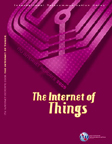
Increasing "availability," Decreasing "visibility"
"We are standing on the brink of a new ubiquitous computing and communication era, one that will radically transform our corporate, community, and personal spheres. Over a decade ago, the late Mark Weiser developed a seminal vision of future technological ubiquity, one in which the increasing “availability” of processing power would be accompanied by its decreasing “visibility”. As he observed, “the most profound technologies are those that disappear…they weave themselves into the fabric of everyday life until they are indistinguishable from it”. Early forms of ubiquitous information and communication networks are evident in the widespread use of mobile phones: the number of mobile phones worldwide surpassed 2 billion in mid-2005. These little gadgets have become an integral and intimate part of everyday life for many millions of people, even more so than the internet. Today, developments are rapidly under way to take this phenomenon an important step further, by embedding short-range mobile transceivers into a wide array of additional gadgets and everyday items, enabling new forms of communication between people and things, and between things themselves". From The Internet of Things by the International Telecommunications Union. [blogged by Jim_Dowing on Smart Mobs]
Posted by jo at 08:50 AM | Comments (0)
December 14, 2005
Performing Presence:
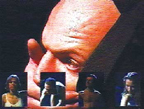
From the Live to the Simulated
Performing Presence: from the live to the simulated: A major AHRC-funded project managed by Nick Kaye (Exeter), Gabriella Giannachi (Exeter), Michael Shanks (Stanford), Mel Slater (UCL). Between February and June 2006, the Centre for Intermedia in the Department of Drama at Exeter University we will be hosting six public one-day practice-research workshops for a public audience conducted by leading theatre and performance artists. Performing Presence is a major, AHRC-funded international collaborative research project running for four years from 1st September 2005.
The project brings together leading researchers from Drama, Archaeology, and Computer Science, in collaboration with internationally known performers and artists, to advance an understanding of the performer's presence in live, electronically mediated and simulated performance. Integral to the Performing Presence project is the Presence Project Collaboratory, a state-of-the-art collaboratively authored web environment hosted by Stanford University. Our Exeter project website is here.
The workshop series will explore theatrical practices that engage with performer-presence and range across multi-media performance, storytelling, intercultural performer practice, performance art, site-specific theatre and psychophysical performance. All our workshops are free and open to a public audience.
Tim Etchells: 15 February 2006, 12.30-4.30: Tim Etchells is Artistic Director of Forced Entertainment, one of the UK's most influential companies working across performance, installation and media.
Phillip Zarrilli and Klaus Seewald: 1st March 2006, 12.30-4.30: Phillip Zarrilli is internationally recognised for training actors using a psychophysical process combining yoga, especially Hatha Yoga, and the Asian martial arts Kalarippayattu and Tai Chi Ch'uan. He is professor of Performance Practice at Exeter. Phillip Zarrilli will conduct this workshop in collaboration with Klaus Seewald of Theatre ASOU, Graz, Austria, whose work has been shown widely across Europe and South America.
Mike Pearson and Mike Brookes: 8 March 2006, 12.30-4.30: In a series of performances since 1999, Mike Pearson and Mike Brookes have explored and studio-based practice as a mediation and transposition of specific sites and events.
Vayu Naidu: 22 March 2006, 12.30-4.30: With Vayu Naidu Company, Vayu Naidu's work explores and articulates the presence of the narrative storyteller, transposing RASA, 'the essence of performance,' toward the creation of performer presence
Details of how to reserve a place are available from http://www.projects.ex.ac.uk/performing-presence/events.php
Further workshop dates and details of individual workshops will be announced in the New Year.
Performing Presence also receives support from Exeter University, Stanford University and University College London.
Posted by jo at 05:06 PM | Comments (0)
Found Connections
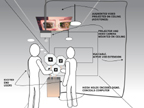
Found Through 'Lost'
Found Connections--by Michael Ang, David Bamford, Joshua Dickens and Karl Channell--allows you to re-experience the narrative of Lost by interacting with other individuals in the physical space and discover your hidden connections through augmented reality. Hold up your fan (with a 4x4" tracker marker printed on it) in front of our installation. Live video is augmented with graphics which reveal a virtual character from the TV show Lost. When more than one character is on the screen, the connections between those characters are visualized between them on the screen. Reverse the fan to find out more details about your connections.
Found Connections is an interactive exploration of social interaction and connections between people using the characters and storylines of the television show Lost as the content. The show Lost is rich with mystery, and hidden meanings; everything from the multiple sides of different characters to the paranormal activity on the island. We want to create the same type of mystery within the Winter Show by giving visitors a simple fan that has hidden content within it that's revealed in front of our installation.
Through augmented reality software these connections are made visible on a plasma screen (or possibly projection) display. The tag on the user's fan turns into a graphic of a character from the TV show and once other users stand in front of the same screen, lines are drawn connecting them as audio, text bubbles and video content from the show are triggered based on which characters are interacting.
This interest viewers based on the interesting content of Lost by really allowing them to take on the role of their character form the show. On another level it also spurs real life interactions with whoever the viewer happens to have a connections with. It reveals hidden connections through augmented reality using lost and also connections that person may happen to have with someone around them.
Part of the ITP Winter 2005 Show.
Posted by jo at 11:53 AM | Comments (0)
Brute Performance Kit

For Impromptu Exhibitionistic Moments
The Brute Performance Kit, by Stephan Hechenberger, is a prosthetic device which both cues a performance and reacts to it by translating movement and speech to sound. We live in a world where we occasionally simply have to bust out a bag of tricks, perform, and enjoy the attention. The Brute Performance Kit is designed for these kinds of impromptu-exhibitionistic moments. It is an apparatus which physically connects two people's heads to form a computer-mediated, pair of people. The primary reason for this cooperation is to move through space and sporadically utter philosophical propositions. Partly such a performance draws its character from the apparatus' blunt visual appearance, and partly from the combination of a live sound track and an algorithmically pro-scripted choreography. Users are cued and sensed. As the users follow commands, the BPK senses movement and utterance from which it composes a unifying sound scape.
There are three distinct parties involved in a performance with the BPK: the audience, the users, and the programmers. Each of them has a different vantage point. The audience are predominantly people of public spaces. They observe two persons being physically and operatively connected to one unit. Movement and speech appears scripted and exhibits a recognizable coherence. Stories are told by two people in unison and a mysticism is generated regarding the internal workings of the box. A private sphere of knowledge is overtly prominent within the public space.
The users wear the device like a helmet. They may roam spaces freely as long as they accommodate for their physical link. Two separate audio feeds--one for each user--tell stories as to why it is important to adhere to the instruction that are to follow. This sets the tone for the users' performance. Once properly introduced the device starts cuing movements and utterances ("move two steps forward, proclaim that your partner is rather slow today"). By sensing physical acceleration and analyzing spoken words the system gauges the level of participation and adjusts the cuing rate accordingly. Should the users discontinue their involvement the device falls back into persuasion mode explaining the importance of this setup. As an additional incentive to engage with the device the users will hear an increasingly more articulated percussion line as they intensify their participation.
The programmers of the box deal with a platform for experiments in the field of human-computer interaction. Unlike the usual one-to-one relation the BPK provides a triangular setup. Part of this setup are exclusive communication channels between the BPK and either one of the participants. This gives the programmers control over four different spheres of knowledge. They can specifically direct story lines at either participant separately, both participants, or the audience. By telling different stories to separate parties they can cause variance in the conception as to what the performance is all about, provoke interference, and interpersonal dynamics.
Part of the ITP Winter 2005 Show.
Posted by jo at 11:39 AM | Comments (0)
Remote Touch
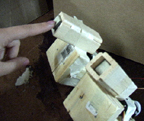
Touching over a Network
Remote Touch--by Myra Einstein and Demetrie Tyler--is also part of the ITP Winter Show 2005. In attempting to send the sense of touch over a network, 2 devices made up of a grid of "touch pixels" will be used. When one device is pressed, the force is applied to the connected device in addition to itself. When the second device is pressed back, the net forces are applied to both. This gives the feeling that you are pressing against someone through a network. Two cameras will be set up so that the user can view what the person on the other side is doing.
When a user pushes on the touch grid, each touch pixel on their own grid will move down according to the force applied and the corresponding touch pixels on the second user's grid will move up. When the second user pushes on their touch grid, each touch pixel on the first user's grid will move up. When both users are pressing on the touch grid, the net force is applied to each touch pixel, ie the touch pixels of the grid of person who's pressing harder will move down and the touch pixels of the other user will move up.
Posted by jo at 11:29 AM | Comments (0)
Franck Ancel: Web Connexion
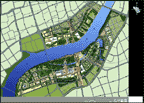
Live Webcast: Lufthansa 727
LIVE WEBCAST on X: - the vision movement in real time from here 2010 / mouvement d'une vision en temps réel d'ici 2010 - December 17, 2005: web connexion from Shanghai to Munich from 18h00 to 19h04 GMT on flight Lufthansa 727 * 2005 TXT 5 PDF on "SPN" http://franck-ancel.com: - SPN from Scenography to Planetary Network / SRP de la Scénographie au Réseau Planétaire. SRP Introduction
SPN for urban screens :-( Amsterdam
SPN to refresh :-) Banff
SPN for e-performance and plug-ins :-| Sydney
SPN to Polieri ;-) Marrakech
*SPN for 2010 :-)) Shanghai
Posted by jo at 10:33 AM | Comments (0)
BOULDER - SCOTTSDALE - SYDNEY - WWW

24 HOUR COUNT: "a blog jam"
The 24 Hour Count is a multi-media blog band made up of Colorado artists Mark Amerika, Rick Silva, and Nathaniel Wojtalik. For this newly commissioned 24-hour online blog performance, the artists will use a variety of media including the Internet, mobile phones, digital video and photo cameras, mini-disk recorders, musical instruments, and many computer software programs to improvisationally remix, interpret, and respond to current events while filtering their "digital readings" through the prism of Count Lautréamont's "Songs of Maldoror," a classic French text written in the 19th century and whom the Surrealists adopted as the progenitor of their significant 20th century movement.
Sponsored by the Scottsdale Museum of Contemporary Art, the Alt-X Online Network, and the TECHNE lab at the University of Colorado at Boulder, the artists performing this distributed multi-media blog performance will be located in three different locations: Sydney, Australia, Boulder, Colorado, and Scottsdale, Arizona.
The event starts December 17th at 14:00 MST/Arizona; 16:00 EST; 21:00 London; 22:00 Berlin; December 18th, 08:00 Sydney.
For 24 hours straight, the three distributed artists will use the same blogging website as the virtual location for their ongoing multi-media jam session. The performance will coincide with the opening of the SOUTHWEST.net:Techno show in Scottsdale, and a living archive of the blog jam site will remain online both in the gallery through May 14, 2006, and on the web throughout the duration of the exhibition and beyond.
Posted by jo at 10:08 AM | Comments (0)
December 13, 2005
GSPS: GumSpots™ Positioning System
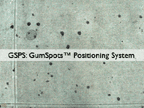
Location Positioning Via Sidewalk Pattern Recognition
GSPS: GumSpots™ Positioning System--by Jason Kaufman and James Sears--is a pattern recognition technology which can be used for a variety of location aware services. Their demonstration of GSPS lets you enter and view hidden data on city sidewalks. A user would take a photograph of the GumSpots with a cellphone and submit it to the GSPS service. The GSPS service would then determine the location and orientation of the image and return the image with extra hidden data displayed on the image. In this case the hidden data will be text as well as 'connect the dot' drawings. A user also has the ability to add hidden text by submitting a note with their image. [via ITP Winter Show, 2005] [Complete list of works here]
Posted by jo at 12:29 PM | Comments (0)
Finger Whisper
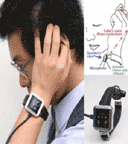
Wired, Body and Soul
In Getting Your Body (And Soul) Wired, Newsweek Magazine reports about Finger Whisper, a wristwatch-phone that transfers voice signals via your body:
"In his gadget-filled office at Tokyo Medical and Dental University, Prof. Kohji Mitsubayashi tells a visitor to touch a transmitter with one hand and a receiver with another. Voila! A jaunty TV jingle blares from a pair of attached speakers. Surprised, the visitor releases both gadgets, and the music stops. The simplicity and strangeness of becoming a human circuit—with electrical signals coursing through one’s body from fingertip to fingertip—is so fascinating that visitors usually repeat the act. “Fun, isn’t it?” says Mitsubayashi, grinning.
Not just fun. Japan is abuzz over the potential of such body-based technology as the ultimate wireless networking tool. A string of Japanese companies are experimenting with systems that use the human body to conduct electricity—some manipulating weak currents that pass through the skin itself (as body-fat scales do), others taking advantage of electrical fields on the surface of the body. Associated products are on the way. The question is whether this represents a paradigm shift in the way we think about wires." [blogged on wristfashion.com]
Posted by jo at 12:21 PM | Comments (0)
Speckled Computing
![]()
Spray on Networks
Speckled Computing offers a radically new concept in information technology that has the potential to revolutionise the way we communicate and exchange information. Specks will be minute (around 1 mm3) semiconductor grains that can sense and compute locally and communicate wirelessly. Each speck will be autonomous, with its own captive, renewable energy source. Thousands of specks, scattered or sprayed on the person or surfaces, will collaborate as programmable computational networks called Specknets.
Computing with Specknets will enable linkages between the material and digital worlds with a finer degree of spatial and temporal resolution than hitherto possible; this will be both fundamental and enabling to the goal of truly ubiquitous computing.
Speckled Computing is the culmination of a greater trend. As the once-separate worlds of computing and wireless communications collide, a new class of information appliances will emerge. Where once they stood proud – the PDA bulging in the pocket, or the mobile phone nestling in one’s palm, the post-modern equivalent might not be explicit after all. Rather, data sensing and information processing capabilities will fragment and disappear into everyday objects and the living environment. At present there are sharp dislocations in information processing capability – the computer on a desk, the PDA/laptop, mobile phone, smart cards and smart appliances. In our vision of Speckled Computing, the sensing and processing of information will be highly diffused – the person, the artefacts and the surrounding space, become, at the same time, computational resources and interfaces to those resources. Surfaces, walls, floors, ceilings, articles, and clothes, when sprayed with specks (or “speckled”), will be invested with a “computational aura” and sensitised post hoc as props for rich interactions with the computational resources.
Posted by jo at 12:11 PM | Comments (0)
Intelligent Environments [IE]
![]()
Intrinsically Motivated Rooms
"Abstract. Intelligent rooms are responsive environments in which human activities are monitored and responses are generated to facilitate these activities. Research and development on intelligent rooms currently focuses on the integration of multiple sensor devices with pre-programmed responses to specific triggers. Developments in intelligent agents towards intrinsically motivated learning agents can be integrated with the concept of an intelligent room. The resulting model focuses developments in intelligent rooms on a characteristic reasoning process that uses motivation to guide action and learning. Using a motivated learning agent model as the basis for an intelligent room opens up the possibility of intelligent environments being able to adapt both to people’s changing usage patterns and to the addition of new capabilities, via the addition of new sensors and effectors, with relatively little need for reconfiguration by humans." From Intrinsically Motivated Intelligent Rooms by Owen Macindoe and Mary Lou Maher, School of Information Technologies, Faculty of Architecture, University of Sydney, Australia.
Posted by jo at 12:00 PM | Comments (0)
December 12, 2005
Pac-Lan
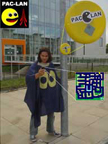
Ghosts in a Maze
Researchers in the Department of Communication Systems, Lancaster University (UK), have developed a game which can be played by up to five players on mobile phones. Pac-Lan enables players to keep track of one another’s position through images on their mobile phones as they chase one another round campus.
Each phone has been programmed with a maze, which is based on a map of the University Campus. Players have to collect points from RFID tags, which have been attached to yellow disks on lampposts around the University. When a player collects their points by holding their mobile phone against the disc the virtual reality maze on each mobile phone is updated with the player’s position. Each player shows up as an animated character (Pac-Lan or Ghost) moving round the screen. This enables a team of "ghosts" to track the player down and catch them.
I do hope that wearing the gown is compulsory for players. More in LU News, The Engineer. More pacman in the streets games: Pac-Manhattan, Human Pacman. List of Location-based mobile phone games. [blogged by Regine on we-make-money-not-art]
Posted by jo at 08:21 PM | Comments (0)
Ruark Lewis and Rainer Linz
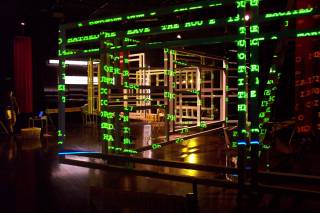
Banalities for the Perfect House
Banalities for the Perfect House--by Ruark Lewis and Rainer Linz--is a collaborative installation & performance work premiered at Sydney's Performance Space theatre on Sept 9 2005. The work proposes the house as a condition through which we perceive the world - the city an extension of grid-like structures viewed through the "frame" of an open window.
Performance texts are distilled from everyday sources including newspapers, cookery books, and snippets of overheard conversation. They consist of seven Banalities: Banalities for the Perfect House, Banalities for Napoleon, Banalities for the Modern Kitchen, Banalities for Solid Mandala, Banalities for Newspapers, Banalities for the Times and Misreading Barricades.
The texts are inscribed on all architectural surfaces, and take the form of performance scripts as well. These include cards, looseleaf and bound pages, and word sequences printed on ticker tape.
The sound is performed on five computer terminals and distributed through a 4-loudspeaker sound system. It is performed using real-time computer processing of original vocal samples, in turn derived from the written texts. The computer sound-generating software was purpose-written for the piece.
The performance space is arranged with wooden frames, boards and barriers resembling, in abstract form, a housing construction site. Each surface is rendered with text creating an immersive environment that can literally be read, and heard as speech.
The work is built around a series of duet and solo performances. Each is based on an individual text, which is the common basis for both the computer and vocal renditions.
The Perfect House is a construction site for ideas, with performers and audiences traversing it as if through rooms made from words whose meanings, too, are still under construction.
Posted by jo at 12:36 PM | Comments (0)
PARLIAMENTS OF ART
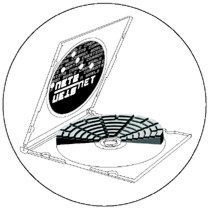
SPRINTOSIUM 05
International symposium and Festival for self-organised cultural forms on the occasion of the start up of the new Viennese support model for net cultures.
SPRINTOSIUM PROGRAMME: 11-13. December 05 (11. 18:00 - 24:00; 12., 13., 10:00 - 24:00)--The central piece of the new Viennese support model for net cultures starting 2006 is the yearly grant of 250 000 ? - with the help of a software based assessment process.
The goal of the symposium Parliaments of Art is to work out the conceptual basis of this new democratic project. "Parliaments of Art" will deal with the material as well as the symbolic dimension of the "art of networking" and the production of new collaborative knwoledge - ideas, images, emotions and relationships.
The software based curator system Mana offers the collective and individual enviroment of action. How is the thinking and doing provided by such a matrix? What as defined as action, what is visible, what is affective? Who or what should be defined as being active? Is it possible to have such a "Parliament of Art"?
With: Richard Barbrook (UK), Sabeth Buchmann (A/D), Karel Dudesek (A/UK), Richard Fajnor (CZ/SK), Tom Fürstner (A), Johannes Gees (CH), Mike Hentz (US/CH), Margarete Jahrmann (A/CH), Vladimir Jeric (SCG), Marko Kosnik (D/SLO), Jacob Lillemose (DK), Christopher Müller (D), Jasia Reichardt (UK), Mirko T. Schäfer (NL/D), Harvey Stanic (D/NL), Nina Stuhldreher (A), Albena Yaneva (A)
href="http://en.wikipedia.org/wiki/Netznetz">http://en.wikipedia.org/wiki/Netznetz
OPENING SESSION: DECEMBER 11th, 7 PM, SEMPERDEPOT (DOORS: 6 PM)
19:30 Keynotes
Jasia Reichardt, London UK: Before and after Cybernetic Serendipity (ICA, London 1968)
Richard Barbrook, London UK: Imaginary Futures. From thinking machines to intergalactic networks
21:00 Discussion:
Parliaments of Art - Which Past should have our Future? Early Perspectives on a Public Experiment in Vienna: Richard Barbrook, Karel Dudesek, Margarete Jahrmann, Marko Kosnik, Jasia Reichardt
Moderation: Andreas Leo Findeisen, Stefan Lutschinger
Visual Ambient: HNS/Lichttapete & Stefano Satori: Pixcompressor via Textmachine Peter Koger: netznetz-list-on-the-wall (live generated visuals); supported by VMS Video Moving System; Audio Ambient--Sweet Susie; Art Haircuts--Marcel. Credits:
Organisation Symposium: Andreas Leo Findeisen, Stefan Lutschinger, Lorenz Seidler / Organisation Workshops: Simon Häfele, Thomas J. Jelinek, Martin Pichlmair, Lorenz Seidler, Nicole Szolga, Andreas Trawöger / Art Director: Jan Lauth / Graphics: Bibi, Wolfgang Schopf /
Production: Bernadette Stummer / Website: Andreas Rathmanner /
Network: Martin Slunsky, Andreas Trawöger / Docu: Gerhard Leixl
Special Thanks: Hans Bernhard, Günther Friesinger, Roland Gratzer, Johannes
Grenzfurthner, Doris Kaiserreiner, Hans Knöll, lizvix, Group Or-Om, Parasew,
Christoph Theiler, Thomas Thurner, Mic Wlodkowski, Julia Zdarsky and all the other participants of Summer Sprint 05, Update and netznetz[at]Künstlerhaus 04 and the Academy of Fine Arts, Vienna.
Posted by jo at 12:25 PM | Comments (0)
December 10, 2005
16 Beaver Presents Steve Kurtz
![]()
Art & Discipline
What: Presentation / Discussion; Where: 16 Beaver Street, 4th floor (directions below); When: Monday Night 12.12.05 @ 7:30 Pm; Who: Open To All.
Our short introductions to events sometimes aspire to a provocation for the evening. How is that we have come so far and seemingly done so little to stop it? How is that we are being disciplined to accept this state of endless war? How is it that so much is being done and yet the same tune plays on? War abroad and war at home. Civil Liberties, "human" rights, open debate, OUT! Torture, abduction, abuse, expulsion, unabashed lies and untold casualties - the stuff of everyday news. Case by case, step by step, it is difficult to tell whether this war without end is reaching its end or sinking into our guts. All be it the language is dramatic, the reality is far more outrageous and devastating.
We are in a state of emergency, a state of exception. What are the implications of this on our activities?
Since the beginning of the case that unfolded against CAE's Steve Kurtz, 16Beaver has attempted to give space to both the intellectual concerns in CAE's work (including the program we organized with CAVS at MIT) and formal and informal discussions we have held about the situation at our own space.
This Monday, we are happy to invite you to a discussion with Steve Kurtz of CAE. We will begin the evening with a presentation, 'Art and Discipline.' In this lecture Steve will discuss the many forms of disciplinary authority that Critical Art Ensemble has encountered over the years, as well as how and why these situations came about. We will follow up this talk with a discussion.
About Steve Kurtz
Steve Kurtz is a founding member of Critical Art Ensemble (CAE). CAE is a collective of tactical media practitioners of various specializations, including computer graphics and web design, wetware, film/video, photography, text art, book art, and performance. Formed in 1987, CAE’s focus has been on the exploration of the intersections between art, critical theory, technology, and political activism. The collective has performed and produced a wide variety of projects for an international audience at diverse venues ranging from the street, to the museum, to the Internet. Critical Art Ensemble has also written five books, and is about to release its sixth work Marching Plague: Germ Warfare and Global Public Health. Kurtz is an Associate Professor of Art at SUNY, Buffalo.
Useful links:
http://www.critical-art.net
http://www.caedefensefund.org
http://www.16beavergroup.org/mt/mtadmin/mt-search.cgi?search=CAE
http://www.16beavergroup.org/MIT/
16 Beaver Group
16 Beaver Street, 4th / 5th fl.
New York, NY 10004
phone: 212.480.2093
for directions/subscriptions/info visit: http://www.16beavergroup.org
TRAINS:
4,5 Bowling Green
R,W Whitehall
2,3 Wall Street
J,M Broad Street
1,9 South Ferry
Posted by jo at 10:26 AM | Comments (0)
December 09, 2005
SoundTransit

Plan a Sonic Journey + Share Sounds
SoundTransit is a collaborative, online community dedicated to field recording and phonography. On this site, you can plan a sonic journey through various locations recorded around the world, or you can search the database for specific sounds by different artists from certain places. If you are a phonographer, you can also contribute your recordings for others to enjoy. The Creative Commons Attribution license encourages the sharing and reuse of all sounds on this website.
Phonography is the art of recording sounds from the environment around us, with an emphasis on the unintentional sounds which often go unnoticed in our daily lives. An international community of phonographers collect and share their recordings...[The] community gets together largely through a website, a Yahoo group and via recordings on various labels such as Seattle's and/OAR records.
On the "Book" page, users can create a SoundTransit by choosing a location of departure and arrival, as well as several stopovers along the way. Based on your selections, an intinerary with details about the selected sounds and a soundfile are generated, which can be downloaded as an MP3 or sent to friends.
SoundTransit began with the project "Phonographic Migrations #3 Soundscape-FM," which was exhibited at the Garage Festival 2004 in Stralsund, Germany. This was followed in 2005 by the "Berlin.Soundscape-FM" website for Transmediale. For both projects, various artists were invited to contribute recordings made either all over the world [soundscape-fm] or within the city of Berlin [berlin.soundscape-fm]. These recordings were made available as an online database, a local FM radio broadcast and a webstream.
SoundTransit is inspired by the "Phonographic Migrations" series, coordinated by Yannick Dauby and Dale Lloyd and published on the labels and/OAR and Tiramizu. These projects enable participants to share sound information about their environments through divergent channels, and consequently to enact a collective soundscape that is materialized into a publication or a public event, physical or on-line. There is no copyright on the "Phonographic Migrations" concept, and anyone is free to initiate a similar project.
Posted by jo at 11:55 AM | Comments (0)
La Box Bourges
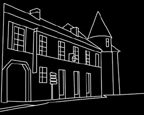
Project Room. A show without works
Sal Randolph's We Are Reading project will launch on December 15, 2005. Until July 2006, she will develop a continuous project on the Internet. In accordance with her interest for open source, copy left, and information sharing, she has conceived a "reading exchange project."
We Are Reading is part of the exhibition Les formes du délai/Project Room. A show without works. The exhibition will concentrate on the absence of the finished and exhibited work of art. Given that a work of art always goes beyond the spatial-temporal framework of the exhibition, the complex network of relations in which the work inscribes itself is worth considering. The work of art, in effect, participates in a series of practices and discourses which take place prior to and/or outside of the work of art. Exposing the forms from which a given work may take its cues or other forms in which it may be absorbed can ultimately shed light on how a work of art operates, from its conception to its reception.
Including exhibitions, screenings, performances, and online projects that will take place over the course of the year, the general programming of "Les formes du délai" will unfold like so many objects of speculation and experimentation, to encourage questioning on the working methods of artists as well as critical or institutional discourse and viewer practices. The various moments devised by the artists will put in balance the effect of the expectations created by the announcement of the work—before it actually takes shape— and the delayed reaction to it once it comes into being.
"Project Room. A show without works"--Preview: 15 December 2005 - 6 pm; Exhibition: 16 December 2005 - 22 January 2006.
la box bourges
école nationale supérieure d'art de Bourges
9 rue Édouard Branly - BP 297
18006 Bourges cedex
tel/fax: 02 48 24 78 70
la.box[at]ensa-bourges.fr
Posted by jo at 11:14 AM | Comments (0)
Finger Lakes Environmental Film Festival
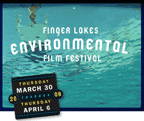
eco-poetics
CALL FOR SUBMISSIONS: Deadline: January 3, 2006: The Finger Lakes Environmental Film Festival seeks seek finished projects of electronic art, ready to be mounted on-line, on the theme of eco-poetics.
eco-poetics: How might new media environments and technological flows intervene in eco-culture and eco-politics? What is the relationship between the techne of eco-poetics and the imperative of eco-politics? How do internet paradigms of speed, flow, and traffic impact notions of sustainability? Do mobile technologies and global positioning systems provide platforms for ecological activism? What about the military's utilization of ludic gaming systems for digital terror and ecological devastation? How might new media interventions offset the media blackouts of the global ecology of war and public health degradation? How can the artistic mixing of ecological and poetic materials-organic, inorganic, technological, aural, visual-create alternative and fertile environments in new media culture?
Selected artistic interventions on electronic interfaces between sustainability and environmental thought will be exhibited at The 9th Annual Finger Lakes Environmental Film Festival at Ithaca College, March 30-April 6, 2006, and subsequently maintained in off-line form in The Rose Goldsen Archive of New Media Art, Cornell University Library.
Please send a description of your project, including conceptual abstract, technical format, and preview URL, to the Festival On-Line Curators, Timothy Murray, Patricia R. Zimmernann, and Tom Shevory: e-mail address: tcm1[at]cornell.edu.
Posted by jo at 10:09 AM | Comments (0)
December 08, 2005
Mendi+Keith live audio stream, December 10
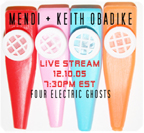
Four Electric Ghosts
Please listen in as Mendi+Keith Obadike present songs and stories from their new work Four Electric Ghosts, created in collaboration with students in the Princeton Atelier. Inspired by Amos Tutuola’s 1954 novel My Life in the Bush of Ghosts and Pac-Man (the videogame created by Toru Iwatani in 1980), Four Electric Ghosts considers the question, "What does it mean to be invaded by an innocent?" The performance will be streamed live from Princeton University on Saturday, December 10th at 7:30pm. You can catch the stream here.
Conceived and directed by Toni Morrison, the Princeton Atelier convenes guest artists to collaborate with students in creating new works performed or exhibited on campus.
Mendi+Keith Obadike are interdisciplinary artists whose music, live art, and conceptual Internet artworks have been exhibited internationally.Their album The Sour Thunder was released on Bridge Records. Their writing and art projects have been featured in the film Take These Chains, in periodicals (including Art Journal, Artthrob, Meridians, Black Arts Quarterly, and Tema Celeste), and in the anthology Sound Unbound:Sampling Digital Arts and Culture (MIT Press, edited by Paul D. Miller). Their work generated much discussion online and offline when they offered Keith's blackness for sale on eBay in 2001. In 2002 Mendi+Keith premiered their Internet opera The Sour Thunder which was the first new media work commissioned by the Yale Cabaret and they launched The Interaction of Coloreds (commissioned by the Whitney Museum of American Art). In 2003 Keith was sound designer and composer for Anna Deavere Smith’s play Twilight: Los Angeles 1992 at the Lincoln Center Institute, and Mendi's poetry was featured at the Studio Museum in Harlem in response to an exhibition of visual artist Gary Simmons’ work. Also in 2003 they launched The Pink of Stealth, an Internet/ DVD surround sound work commissioned by the New York African Film Festival and Electronic Arts Intermix and The Sour Thunder was broadcast internationally from 104.1 fm in Berlin. Their upcoming projects include a new installation and album entitled TaRonda Who Wore White Gloves supported by a Rockefeller Media Arts Fellowship and an Internet opera entitled Four Electric Ghosts, for Toni Morrison’s Atelier at Princeton University in 2005. Most recently, Keith was awarded a Connecticut Critics’ Circle Award for his sound design work at the Yale Repertory Theater and Mendi's new book Armor and Flesh (Lotus Press) won the Naomi Long Madgett Poetry Award. Keith received a BA in Art from North Carolina Central University and an MFA in Sound Design from Yale University. Mendi received a BA in English from Spelman College and a PhD in Literature from Duke University.
Posted by jo at 04:31 PM | Comments (0)
All Together Now:

Collective Knowledge... Narratives... Architectures of Participation
"ABSTRACT: This essay is an exploration of the history and methodologies of collective narrative projects, and their relationship to collective knowledge projects and methodologies. By examining different forms of conscious, contributory, and unwitting participation, the essay attempts to develop a richer understanding of successful large-scale collaborative projects. The essay then examines largescale architectures of participation in Wikipedia and Flickr to extrapolate from those observations potential methodologies for the creation of collective narratives.
Keywords: Collective, social, systems, literary, collaboration, hypertext, constructive, constraints, writing, process, architecture, participation, narrative, literature." From All Together Now: Collective Knowledge, Collective Narratives, and Architectures of Participation by Scott Rettberg, The Richard Stockton College of New Jersey Arts and Humanities, Literature Program. Presented at DAC 2005. [via elo]
Posted by jo at 01:12 PM | Comments (0)
0100101110101101.ORG
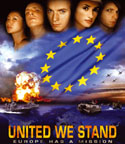
United We Stand
Postmasters Gallery is pleased to announce the exhibition United We Stand, a new project by 0100101110101101.ORG (Eva and Franco Mattes) and their first solo show in New York. "United We Stand: Europe has a mission" is the title of the non-existent, fully EU-produced Hollywood-style blockbuster: "A brilliant mix of espionage and sci-fi political stereotypes in which Europe, not the US, saves the world from impending doom". The project that convincingly invents and promotes this movie is disseminated into public spaces and media realm all over the world through city-scale urban installations and viral communication tactics.
The streets of Berlin, Brussels, Barcelona and, now, New York have been plastered with thousands of posters perfectly mimicking the iconography and the rhetoric of Hollywood-style visual propaganda. This is the first stage of a long-term communication strategy that began in late 2005 and will gradually cover the whole media spectrum from blogs to magazines and TV. Full page United We Stand ads have been spotted all over Europe, in magazines devoted to art, youth culture and life styles. More are to come.
United We Stand touches on themes of subliminal art, cultural propaganda and European identity, clashing against expectations and exploding cultural stereotypes. Like Mattes' previous large-scale work Nike Ground, United We Stand provokes an unexpected wave of collective hallucination where over-identification, falsehood and consequent disclosure are key elements that foster critical thinking.
While the the advertising campaign exists publicly, it is simultaneously presented (revealed) as as an artwork of 0100101110101101.ORG. Postmasters Gallery will be the first art venue to host the disclosed side of the United We Stand project. The light boxes and a billboard with the movie poster, a comprehensive collection of photographs of the United We Stand campaign so far, including urban installations in key locations of Berlin, Brussels, Barcelona and New York, the website devoted to the film, and framed magazines with the ads, will all be on view. The gallery exhibition will also feature a site specific "bridge" installation with live images from a hidden webcam capturing the passerbys reactions to the poster. We are working simultaneously on this double track, the fictional and the real - explains Franco Mattes - in this sense, spectators in the gallery who are aware of the multiple layers are passive voyeurs, while the unaware public, is actually a part of the artwork.
The show will open December 10 and will be on view until January 21, 2006 (gallery will close for holidays December 24 - January 2). The opening reception will take place Saturday, December 10, 2005 between 6 and 8 pm.
The site specific installation is realized with assistance of the New York University, the poster campaign in New York is carried out within 0100101110101101.ORG's residency at The Thing.
Eva and Franco Mattes - internationally known as 0100101110101101.ORG - are a couple of restless European con-artists who use non-conventional communication tactics to obtain the largest visibility with the minimum effort. Born in 1976, they live and work in situ. In the last decade they have been devoted to what they define as "media actionism", where truth and falsehood become indistinguishable. They invented and promoted a nonexistent artist; spread a computer virus as a work of art; challenged and defeated Nike Corporation in a legal battle for a fake advertisement campaign. They have been called media scammers, myth-makers and extremists as well as Internet stars, info-dandies or, simply, geniuses.
Their works have been shown internationally including: Lentos Museum of Modern Art, Linz; New Museum of Contemporary Art, New York; ICC, Tokyo; Manifesta, Frankfurt; Venice Biennale, ZKM, Karlsruhe; Generali Foundation, Vienna; Muse d'Art Moderne de la Ville de Paris.
Postmasters Gallery, located in Chelsea at 459 West 19th Street (corner of 10th Avenue), is open Tuesday through Saturday to 11 - 6 pm. Please contact Magdalena Sawon at 212-727-3323 with any questions or image requests. e-mail: postmasters[at]thing.net
Magdalena Sawon
Postmasters Gallery
459 W 19 Street
New York, NY 10011
phone 212 727 3323
Posted by jo at 11:54 AM | Comments (0)
Opsound + Glowlab Open Lab
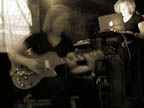
Look, Listen, Interact, Play, Contribute
Opsound is pleased to announce an exciting line-up for the closing party of Opsound's Open Sound Exchange and Glowlab's Open Lab to take place Sunday, December 11 at Art Interactive Gallery in Cambridge, Massachusetts from 4-8pm.
Performances in the gallery will include a live video and audio stream by LoVid, an interactive audio piece for mobile phone handsets by RZ-1 Mobil Tek, plus experimental ambient live music by Eric Raz, Brad Bordine, and Weapons of Mass Destruction, additional sounds from Opsound's collaborative internet radio stream.
Directions and Information: Sunday, December 11, 4-8pm; Art Interactive
130 Bishop Allen Drive, Cambridge, MA; 617-498-0100, info[at]artinteractive.org; Subway: Central Square [Directions/map]
Performers:
LoVid--LoVid is Tali Hinkis and Kyle Lapidus. Using homemade electronic devices and DIY sculptural instruments, LoVid overwhelms the senses with new media in their performances, videos, objects, and installations. LoVid has toured the US and Europe extensively performing among many others at Eyebeam, Harvestworks, Boley, Max Protetch, Eyedrum, NY Underground Film Festival, Look and Listen Festival, Kraak(3) Festival, Lokaal01, Lumen, and Futuresonic Festival. LoVid has exhibited among others at COCA Seattle, Sotheby's, SOUTHFIRST, Happy Lion, Institute of Contemporary Art London, and The New Museum of Contemporary Art. LoVid is currently artist in residence at Eyebeam, has been selected as artist in residence at Harvestworks and iEAR, has been nominated free103point9 transmission artist, and has recently received a grant from NYSCA. A DVD of LoVid recordings made during a residency at Experimental TV Center has recently been released on CollectivEye.
RZ-1 MobileTek--Glad to be back in the Boston area. My roots. Searching for new methods to release sound into our environment. Currently developing audio software for the cell phone. Recently completed projects include New Conventions of Behavior - An experimental sound work that investigates how listeners create cognitive structures for understanding new sounds, and how composers organize sound structures into pieces. Auracle: a voice driven, interactive and colloborative instrument. The project was led by Max Neuhaus and realized with a team of fellows at Akademie Schloss Solitude in Germany.
Eric Raz--Soundscapes (guitar & looping) Graduate of the School of the Museum of FIne Arts. Also a visual artist; batik, lighting, printmaking.
Brad Bordine--Free electronic sound environments drawn from a palette of synthesis and environmental recordings.
Weapons of Mass Destruction--Weapons of Mass Destruction is a Brooklyn-based guitar and laptop band, specializing in semi-ambient deconstructions and blasted-open pop covers. WMD are Sharilyn Neidhardt (guitar, keyboard, vocals, and sounds) and Sal Randolph (laptop, rhythms, vocals, field recordings, sounds). They have performed at The Bowery Poetry Club, Pianos, and Subtonic and Trash in New York, as well as in clubs, pubs and galleries the UK and Germany.
Opsound's Open Sound Exchange: Boston
Beginning October 14, Opsound's Open Sound Exchange: Boston will be part of Glowlab's "Open Lab", an exhibition and festival of psychogeographic explorations headquartered at Art Interactive. Opsound will be collecting and generating a sound portrait of Cambridge and Boston through recordings in the gallery, sound gathering walks through various neighborhoods, and via contributions from sound artists and musicians over the internet. All the collected material will be broadcast as a 24/7 internet radio stream -- a special edition of the 'opstream' -- that will grow throughout the exhibition.
About Opsound: Free Love, Free Music.
Opsound is a gift economy in action, an experiment in applying the model of free software to music. Musicians and sound artists are invited to add their work to the Opsound pool using a copyleft license developed by Creative Commons. Listeners are invited to download, share, remix, and reimagine. Opsound is a project of artist Sal Randolph.
Musicians and sound artists are invited to add their sounds to the project.
Opsound's Open Sound Exchange: Boston is gathering material for an open pool of sounds relating to the city. Boston real and Boston imaginary, Boston past and Boston now: yelling cabbies, Rat new wave, Fenway Park crowds, sunday afternoon string quartets, harbor noises, sidewalk folk singers, Composers in Red Sneakers new music, banker high heels, museum whispers, Media Lab algorithms, Big Dig construction, student arias. every city is a world of sound -- help discover Boston's by creating a kaleidoscopic sonic portrait. Contributions can include work from, about, or inspired by the idea of Boston. Boston sounds, including field recordings from various parts of the city, are already in the pool and available for remixing.
To contribute, simply add your sounds to opsound, and tag them with the word "boston."
Glowlab: Open Lab
Curated by Christina Ray
A nine-week-long psychogeography festival and exhibition
In Fall 2005, Art Interactive is conducting a nine-week-long experiment. We have invited artists affiliated with Glowlab, a network of psychogeographers, to use the Central Square neighborhood as the site of their research and fill the exhibition space with the results of their investigations. PSYCHOGEOGRAPHY, a term coined by the Situationist International in the 1950s and appropriated by contemporary artists, is used to describe projects that produce affect in relation to the geographic environment. Rather than making maps in the traditional geographic sense, these artists utilize maps and geography to conduct located experiments with (among other things) people, trash, bikes, clothes, the sky and the gallery space itself. Often making use of mobile technologies and existing in the hybrid spaces of the Internet and the physical world, their projects produce new understandings of location and identity as shifting, fluid, singular and irreducible.
Central Square, Cambridge, MA, will never be the same again. Join us for nine weeks of public walks, talks, tours, workshops, concerts, group bike rides, and other ways of exploring the Central Square neighborhood. Each weekend of the festival, different Glowlab artists will be present to lead participatory public events inside and outside the Art Interactive space. Visit the online schedule at for more details about upcoming events or email info[at]artinteractive.org.
Glowlab: Open Lab
Opening Reception: Friday, October 14th, 2005, 6 - 9pm
October 14 through December 11
Gallery Hours & Location:
Art Interactive is open Saturdays and Sundays from 12 - 6pm or by
appointment. The gallery is located at 130 Bishop Allen Drive, at the
corner of Prospect Street in Cambridge, MA. For more information,
please contact info@artinteractive.org, call 617-498-0100 or fax 617-498-0019.
Press release with downloadable press kit.
Posted by jo at 11:05 AM | Comments (0)
Call for Proposals

ParticipART Conference and Exhibition
Participatory Design Conference 06, Trento, Italy, July 31- August 5, 2006: The conference includes an "arts track" cosponsored by the local art museum where performers can present either completed works or works in progress that specifically incorporate participatory processes, whether that is in the creation of the work or during the event(s) itself (or some combination thereof!). You may also want to look at the guidelines for presenting workshops.
Please note that this is not a "cyberart" conference per se. Participatory processes, and critical reflection on those processes, are what is important. PDC is a lively conference and an unusual opportunity for artists to meet informally with socially aware computer and industrial design professionals who work at the "leading edge" of technological development.
PDC focuses on the design and development of computing and information technologies in diverse social contexts, with the active collaboration of people who use or are affected by these systems. Over the years, our design discussions have been enlivened and enriched by the efforts of musicians, architects, computer graphic designers and artists working across a wide range of disciplines. Artists presenting their work at PDC '06 will enjoy a rare opportunity to reach a technically expert and socially engaged community of practitioners. Contact: art[at]pdc2006.org
ParticipART will be an exhibition on participative and electronic art at the MART (Museum of Modern Art of Trento and Rovereto, Italy) from the 2nd to the 4th of August 2006. ParticipART invites artists, musicians, game designers and performers to submit proposals of art works to be part of a public exhibition, performances, and discussions.
Topics: ParticipART is the Art Track of the Participatory Design Conference (PDC). The PD community is interested in taking inspiration from and collaborating with artists and designers engaged in creative practices that support new roles for visitors/viewers as active spect-actors and co-authors.
Invited Artists and Works: Artists/designers working in the field of visual, installation, and performative arts are invited to submit projects that allows participants’ interactions to become part of a piece of art or performance. Projects should address/explore the theme of ‘boundaries’.
Reviewing Process and Publication: Projects will be reviewed and curated by an interdisciplinary group of experts, including Giorgio Verzotti, chief curator of MART (Museo d’arte contemporanea di Trento e Rovereto: www.mart.trento.it). For accepted works, a two page description will be included in the proceedings of the PDC 2006 ACM published in the International Conference series. In addition to the hardcopy form, papers will also be published via the web in ACM's Digital Library.
Exhibition and Discussion: Selected projects will be displayed at MART as part of a special event with the opportunity for discussion and feedback from conference participants.
Submission Guidelines: Please submit a 2 page description of the art work (submission web site to be announced), with links to previous work (or a CD), in which the project is described, its relation to partecipation, and specific requirements for display.
Submit your proposal by the 16th of January 2006 to the email address:
art[at]pdc2006.org
Posted by jo at 10:22 AM | Comments (0)
b-l-u-e-s-c-r-e-e-n

transversalMemory
transversalMemory Performance Instance #04: France, Lyon, Friche_RVI; Algorithm & Pix :: BlueScreen | Sound :: Julien Clauss | Light :: Karim; 2005.12.10_21h00 [december 10]
As one takes a photograph with a digital camera, a different name is given to each photograph by the camera. The form of this name is specific to the camera model. It usually comes as a an alphanumeric characters series which includes the camera model reference and a number identifying each image.
Whether they are intended to be publicly displayed, exchanged in a private or restricted context, or to be stocked, a large amount of these photographs end up being accessible on the internet, without the photographer even being aware sometimes. For each photograph we take, it is then possible to find on the net its twin images, that is to say photographs taken somewhere on the planet with a similar camera and bearing the very same name.
The transverse memory performance intends to connect a photograph taken at a given time and place with its twin images collected in real time on the internet. Once the photograph is taken in situ and through this photograph, an image of the place is projected ; a robot begins a silent exploration of the network, searching for images bearing the same name. These images gradually mingle one with the other without ever replacing the initial photo or being fully identifiable, thus opening spaces for the viewers mental journeys.
From the original image, we progressively slip mentally towards a succession of new situations, carried by the appearance and changing of different images mingling. The process taking place seems to bring to the foreground an imperceptible and imaginary dimension of the performance physical location. A dimension which stands somewhere between a fictitious past and a remote present. Even though no sense can clearly be established by what is given to see, the shift of the situations led by the atmospheres arising from the mixing of those images is an invitation to reverie, to the construction of a narration based upon the viewer's perception and individual sensitivity. Potential situations thus take shape, open fragments of narration carried out by the ability this process possibly holds to reveal, through the photography, a poetic and impalpable story of the place we are watching. It is only after a certain time, as we begin to sense the image through which it all started again, that we realise we had been carried away from it. We then have the strange feeling we are returning to a certain reality...
Posted by jo at 10:02 AM | Comments (0)
Cory Arcangel

Friendster Suicide
Dear Internet,
I am writing this to announce that I am going to commit Friendster Suicide on Thursday, ---> aka. delete my Friendster account. Yep, I just can't take it anymore. To my Friendsters, I'm sorry, ... c u on the net.
I am gonna do this as part of the launch of the Dec/Jan issue of the magazine The Believer @ ps1 on Thursday. The event starts at 6pm and also will feature lectures and talking by other people like Eric Fischl, Matthew Ronay and Lori Barbara.....for more info click here.
So yeah, if you want to see this live, please come, and if you want to watch the performance at home (yes, ... this is an Internet performance, remember that concept???? LOL!), Friendster me sometime before then, and around 8:40 EST on Thursday(ish), I assume if you keep reloading your browser window on Friendster, I think I will simply disappear from your friend list. Got it? Awesome. C U there, ... kinda.
l88888888r, Cory
Posted by jo at 09:50 AM | Comments (0)
V2_Lab: Disembodiment in Virtual Environments
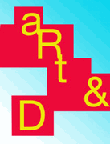
Artist-in-Residence Call for Proposals
Deadline: 15 January 2006--V2_Lab, the artistic research & development (aRt&D) department of V2_, Institute for the Unstable Media, in Rotterdam, The Netherlands, has a vacancy for an artist-in-residence funded by the Pauwhof Fonds in 2006.
V2_Lab is a workspace for artists, scientists and technicians emphasizing the encounter and exchange between different disciplines. Main areas of the V2_Lab's aRt&D are: Interactivity and Alternative Interfacing, Wearable Technology, Virtual Reality, Multi-user Environments.
Residence: Europe-based media artists in the fields of interdisciplinary digital media are invited to submit proposals for this unique artist-in-residence position at V2_Lab in the period 1 April - 31 May 2006. The artist-in-residence will take place in the context of collaboration with Erasmus MC, University Medical Centre Rotterdam. The aim of the residence is to integrate biomedical scientific topics with artistic research and development.
The accepted proposal will be realised in close collaboration with three other parties involved in a larger research framework of the national project MultimediaN; Waag Society, TU Delft, TNO.
Theme: The theme of the residency is Disembodiment in Virtual Environments. Proposals should concern artistic investigation of physical experiences on the border between virtuality and reality. The product of the residency should be an interactive artwork that can be exhibited in the Erasmus MC’s I-Space, a (CAVE™-like) cubicle Virtual Reality environment that enables interactive projection on all its walls.
V2_, Institute for the Unstable Media
Eendrachtsstraat 10, 3012 XL Rotterdam, NL
PO Box 19049, 3001 BA Rotterdam, NL
Tel + 31 10 206 72 72 | Fax + 31 10 206 72 71
E-mail info AT v2.nl | URL http://www.v2.nl
Posted by jo at 09:39 AM | Comments (0)
December 07, 2005
My Beating Heart

Heartbeats in Sync
My Beating Heart--by Yury Gitman--is a soft huggable heart with a soothing heartbeat you can really feel. When hugging the heart, the tactile heartbeat reminds you of holding a pet or a loved-one. Hold the heart a moment and you'll begin to sense your own heartbeat slowly syncing with My Beating Heart's carefully designed rhythm. My Beating Heart is designed to help you relax, daydream, meditate, and nap.
Each "Beating Heart" is handmade in New York and is of museum quality. The use of only the highest quality materials makes for an experience that will last for years. Select a style that looks most cuddly to you.
Posted by jo at 06:17 PM | Comments (0)
Smart Jigsaw Puzzle Assistant
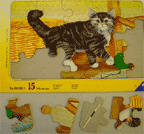
RFID and Games
"ABSTRACT: Radio Frequency Identification (RFID) can be used as technology for coupling the physical and the virtual world in ubiquitous computing environments. In this paper, we show that RFID is also a very interesting option for building augmented real-world games. First, we describe several advantages of employing RFID technology for the development of gaming applications. Then we present the Smart Jigsaw Puzzle Assistant, a fully operational augmented jigsaw puzzle game which we have developed and prototypically implemented using miniature RFID tags and a palm-sized RFID scanner." From The Smart Jigsaw Puzzle Assistant: Using RFID Technology for Building Augmented Real-World Games by Jürgen Bohn.
Posted by jo at 01:27 PM | Comments (0)
Gesture-Based Games Using Camera Phones
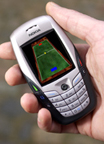
Physically Moving the Phone in Free Space
"We have developed a collection of mobile phone games that incorporate physical gesture interactions. Users interact with the game by physically moving the phone in free space. For example, in Pong, a user moves the phone left and right to control the paddle. The games do not rely on special motion sensors. Instead, they use the mobile phone’s camera as the motion detector. By using computer vision techniques like motion blur detection and optical flow it is possible to detect up to 6 degrees of freedom. We have developed three entertainment applications to explore this application domain. The first is a simple single player Pong game. The second is a Doodle application that demonstrates the various degrees of freedom. The third is a multiplayer version of the Pong game that leverages the Bluetooth capabilities available on many camera phones." From Gesture-Based Games Using Camera Phones, Mobile Technologies Group, Georgia Tech. [blogged by nicolas on pasta and vinegar]
Posted by jo at 01:09 PM | Comments (0)
Wired
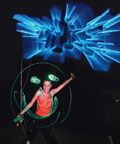
Graffiti Hackers
Graffiti Hackers: Text-message projectors. Paintball printers. Wall-crawling robots. The new crew of tech taggers makes a name for itself. By Sonia Zjawinski
"...FLASHLIGHT BRIGADE: Who: PIPS: lab art collective; Where: Amsterdam; How: Audience members are asked to draw using a variety of light sources: an aerosol can rigged with a 3-volt bulb for producing skinny lines, a battery pack attached to a handheld 12-volt lamp to make thicker strokes, or a 220-volt spotlight for larger-than-life beams. A digital camera set for a 30-second exposure captures the light trail. A brief flash ends the shot, revealing the artist and capturing the scribbled illustration. (Pablo Picasso did much the same thing for photographer Gjon Mili in 1949.) Stills and video of the installation, called Lumasolator, are displayed during the performance and uploaded onto the group's Web site. Word: "Graffiti belongs to the people, but not everybody is allowed to express themselves on the streets," says PIPS:lab cofounder Keez Duyves." Continue reading >>
Posted by jo at 12:48 PM | Comments (0)
December 06, 2005
CALL FOR PAPERS: WAVES
![]()
Electromagnetic Waves as Material and Medium of Art
w a v e s Electromagnetic Waves as Material and Medium of Art, (Acoustic Space. Issue #6): We are seeking manuscripts for the upcoming Acoustic Space journal, to be published for the 8th international Art+Communication festival that will celebrate its 10th anniversary in Riga Latvia, from August 24-27, 2006. For the first time the festival will be conceived as a large scale exhibition event that focuses on the phenomenon of "electromagnetic waves".
The print journal, Acoustic Space is a forum for net.radio, sound art and creative explorations in the networked electro-acoustic environments. Now in its 6th edition, Acoustic Space WAVES Issue will deal with properties of waves in imaginative ways, exploring, making visible or making us feel waves on a host of different bands of the spectrum.
The main thesis behind the WAVES idea is that when artists take waves seriously as the medium of their artwork, they start questioning the boundaries of what can be done with this medium. Electronic information is a tightly controlled sphere. Yet artists with their electronic DIY kits have found numerous ways of thinking outside the box, making their own waves, creating alternative networks and facilities or creatively abusing existing technology.
The publication seeks to offer a space of exchange for artists, scientists, media theorists, radio activists and new media practitioners who are exploring ideas and notions in relation to electromagnetic waves, spectrum space, and also waves as a universal principle.
* Themes and subthemes:
> scientific/artistic: - radio astronomy - radio cryptography - spectrum
mapping - radio oceanography - climate change research - visualisation and sonification - ...
> alternative communication systems: - ad-hoc networking - wireless - ...
> wave philosophy: - wave-particle duality - wave sculpture -
signal-to-noise ratio - determinism vs indeterminism - quantum spacetime bubbles - ...
> social movements: - social cycles - Kondratiev - ...
> psycho-esoteric-utopian: - ESP, Raudive, Jirgenson - psycho climate
research - Tesla - Schauberger - ...
We encourage you to submit abstracts first. Proposals and inquiries regarding submissions should be made to Rasa Smite rasa[at]rixc.lv
Deadline for submissions: February 1, 2006 (for abstracts)
(+ for finished texts: April 15, 2006)
* Conceptual background:
Pantha Rei - Everything Flows
By Armin Medosch
Radio waves occur naturally. Society puts the biggest emphasis on the ability of waves to carry signals. Radio, television and mobile telephony are some of the most widely used applications. The worlds fixation on content and its socio-political implications makes us forget the waves themselves. The proposed exhibition takes a look at the physical properties of waves. Waves are considered to be 'immaterial' from the point of view of visual art. However, light is just a specific band in the spectrum of electromagnetic waves. Some of the properties of waves change according to their frequency and wavelength. It is worthwhile looking at those properties and exploring their implications for art. Wave-like phenomena play an important role in various aspects of reality, from the physical consistency of the world (audio-, air-, water-waves) to Kondratiev-cycles and the carbon-cycle (the storage and release of CO2 by oceans and forests).
A materialistic analysis of waves reveals that there is a direct relation between the wavelength and the length of an antenna - the device necessary to receive and send waves. [lambda] = the wavelength of an electromagnetic wave is the result of the speed of light divided by the frequency. For instance, the frequency on which wireless lan operates, is 2.4 Gigahertz. 300 000 / 2400 000 = 0.125 km or 12.5 cm. The length of the antenna needs to be [lambda]/2 = 6.25 cm or multiples of it. Through this formula expresses itself a link between immaterial wave and physical object. The antenna as an object combines sculptural and functional aspects.
We cannot speak about waves without mentioning wave/particle duality. Light and electromagnetic radiation are actually not only waves but also exhibit properties of particles. Wave-particle duality also applies to matter. Thus, the 'building bricks' of matter need to be understood also as waves. The relationships between wavelength, mass, energy and speed offer exciting possibilities for an artistic exploration of the ontological status of affairs. Since 100 years we cannot take the physical status of the world for granted and must live with an understanding of spacetime which is counter-intuitive and hard to visualize. For art, this is an interesting opening, a chance to ask the big questions about fundamentals such as time, space, energy and substances.
It is a basic property of waves to create connections. Through the antenna we get access to Hertzian space. Artists using electromagnetic waves as their medium are creating wave-sculptures, real-time connections in time and space, which allow us to enter another space. Those connections can go both ways from formlessness to form and structure and back -- the materialisation of the inconcrete and its opposite.
Around planet earth a tight information sphere has been formed. Whereas some artists explore this thicket of global communication networks with various probing techniques, it becomes increasingly clear that it does not make much sense to add just another communication channel to this already babilonic mess. Increasingly artists focus on experimenting with their own signals and systems instead of relying on the commodified information infrastructures of the global media sphere. By creating mobile ad-hoc networks or by pointing antennas towards outer space or the depth of oceans artists literally open up the horizons towards the possibilities of a new way of seeing and interacting with the world.
About Acoustic Space: Acoustic.Space.Re-search.Lab aims to re-approach collaborative audio communication tools, to broaden the meaning of "net.radio"--beyond the confusion of streaming media standards and its technical limitations, and to set up new context for research on "data ecology" and co-experiments in the field of networked media, radio and satellite technologies.
* Editorial team: Concept: Armin Medosch armin[at]easynet.co.uk; Editors: Rasa Smite rasa[at]rixc.lv, Armin Medosch, Raitis Smits
* Contact: rixc[at]rixc.lv
The RIXC, The Center for New Media Culture
11. Novembra Krastmala 35 - 201, Riga, LV 1050, Latvia.
Tel. +371-7228478, +371-6546776 (mob.),
Fax: +371-7228477
URL: http://rixc.lv
Posted by jo at 03:30 PM | Comments (0)
RADIO WAVES

WORKSHOP, LECTURE AND LIVE NET.RADIO SESSION
Friday, December 9, 2005, 17.00 – 23.00; [location] RIXC Media Space, 11. Novembra Krastmala 35, in Riga/Latvia. Live transmission on the internet. [Free entrance] [For participation in DIY radio workshop, please contact: rixc [at] rixc.lv]
RADIO WAVES is a programme of the 8th international "Art+Communication2006: WAVES" festival (that will take place in Riga , August 2006) introductory event series. The RADIO WAVES event programme includes: DIY radio workshop and lecture by new media artist Adam Hyde (New Zealand), online introduction by radio activist Tetsuo Kogawa from his studio in Japan (live via the internet), discussions on inter-relation of local/global and net/fm [radio] and alternative explorations of radio spectrum; as well as djs, music and live net.radio performances.
Posted by jo at 03:23 PM | Comments (0)
On The Road: A Kerouac Circus

Transform a Book into a Performance
On The Road: A Kerouac Circus is a mixed-media event based on Jack Kerouac's classic American road-trip novel, using a set of procedures created by American composer John Cage to "transform a book into a performance."
Organized by Marc Thorman, the On The Road: A Kerouac Circus web site is part of a project to gather ambient sounds (sounds that happen to be in an environment) from locations mentioned in Kerouac's "On the Road" in order to create a sonic portrait of the big cities, small towns, backwoods, deserts and mountains that Kerouac visited and wrote about.
The project invites you to represent a location in the US, Mexico, or elsewhere by uploading a sound file for the mix of recordings that will be played during the performance.
You and/or your organization will be credited if you wish. (Hard copies -- CD's/flashcards -- can be sent by mail.) These sounds will be mixed with fragments of bop, folk, jazz and mambo recordings, vintage film clips, and live performances to create a "musicircus," the term Cage coined to describe an event in which many independent sounds and sights occur simultaneously and interact freely.
To participate, record ambient sounds (sounds that happen to be in the environment) at an urban or rural location listed on the locations page. These can be sounds of traffic, birdsong, wind, machines, footsteps, water, etc. This isn't a contest for "interesting" sounds -- ALL ambient sounds are welcome. You can choose to record at a specific site that is representative of the location, or choose a site by chance. Collect whatever sounds are there without knowing beforehand exactly what they will be.
Background
John Cage invented a new type of mixedmedia theatrical event, using chance combinations and multiplicity to reflect the way we experience the everyday world. In such a "musicircus" the elements--poetry, sound, dance, music--are created independently and then, like a three-ring circus, performed simultaneously. Cage's philosophy was that the chance combinations and multiplicities that arise from a musicircus are more interesting, and truer to our everyday life, than fixed relationships intentionally imposed by one individual.
In "_____ Circus On ____" Cage established a set of procedures to "transform" a book into a musicircus. The first "Circus On" was Cage's own "Roaratorio, An Irish Circus On Finnegans Wake." As Cage recited his poem taken from Joyce's novel, recorded ambient sounds from Ireland and around the world played through multiple speakers, Irish musicians played traditional instruments and sang, and dancers performed Merce Cunningham's choreography based on Irish dance. [Mode Records has recently re-issued the recording of "Roaratorio" with a comprehensive booklet containing an interview with Cage and a detailed explanation of each stage of the work.]
Applying Cage's procedures to "On The Road" creates a distinctly different musicircus, filled with sounds and images of cars, railroads, Americans towns and cities, be bop, old movies, mambo, cornfields, Sierra Madres, swamps, and prairie winds. The structure follows Kerouac and Cassady as they crisscross America from New York to San Francisco/L.A. and then drive through the South and into the roaring boulevards of Mexico City. The poem for the musicircus, composed entirely of word fragments from the book, reflects Kerouac's spontaneous prose rhythms and American speech patterns. Live performances, to be combined with the reading of the poem and the mix of sounds, come directly from the pages of the book--at various times during the performance (sometimes overlapping by chance) a DJ spins jazz tunes, dance couples swing and mambo, a bop trio blows, a folksinger sings "Halleluiah I'm a Bum" and clips from movie scenes are screened. Other live performances may include strolling guitarists singing Mexican songs, a nightclub singer, and an operatic tenor's a capella rendition of "Gott! Welch Dunkel hier!" from Fidelio.
Posted by jo at 02:44 PM | Comments (0)
Emvelope Inserts
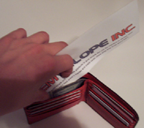
Complete Protection
The Emvelope® Wallet Insert is an innovative, patent-pending product that provides a simple, convenient, and easy way to contain the wireless signals being emitted by RFID chips. Simply place the insert into the bill area of your wallet and press firmly around the edges. Close the wallet and you'll have a Faraday Cage small enough to slip in your pocket. Don't let the size and simlicity fool you. Emvelope® inserts will block RF frequencies up to 2.4Ghz. More than enough to insure your safety. And it will do so for the low cost of $10.
"It is our goal to give our customers the comfort and security of knowing they choose when and where their every day items share their identities and credit accounts with those around them. We hope to solve this problem before it starts."
Posted by jo at 02:35 PM | Comments (0)
GAMING WORKSHOP

Exploring Different Aspects of Game Culture
Friday/Saturday, 9 and 10 December, 2005--Facilitated by Josephine Starrs and Leon + Anand Vivek Taneja--In this two day workshop Josephine and Leon Cmielewski will demonstrate a range of works exploring different aspects of game culture, including digital game modification, game art, machinima, mixed reality games, locative based gaming and the concept of gameplay. Ideas of 'gameplay' include interactivity design which may take many forms. For example decision making, navigating space, the structure of game content, collaborative or competitive interaction with other players, and the physical aspects of play.
The workshop will consist of demonstrations, practical exercises, and experiments in the development of locative games. Participants will combine a walk through Delhi University, the site of the workshop, with Anand, and material they gather will form the basis for developing a gaming experience.
Josephine Starrs and Leon Cmielewski are Australian media artists who have worked together on several projects which incorporate the language and structure of digital games. They use play in their work as a strategy for engaging with the social and political contradictions inherent in contemporary society.
Anand V. Taneja is a researcher with the Publics and Practices in the History of the Present project, Sarai-CSDS.
For more details and to register for the workshop, write to: aarti[at]sarai.net. Sarai.
Posted by jo at 12:35 PM | Comments (0)
transmediale.06

REALITY ADDICTS
transmediale.06: REALITY ADDICTS, Berlin, February 3 - 7, 2006, Akademie der Kuenste, Berlin, Hanseatenweg 10.
Nominations for the transmediale award 2006: 1. Competition 2. Roermond-Ecke-Schoenhauser 3. Eisbergsonde 4. Vexations 5. Burn Station 6. Point and Line to Plane 7. Google will eat itself 8. Honourable Mentions.
1. Competition: 1001 artists from 52 countries applied for the transmediale award 2006. An international jury, composed of Kazunao Abe (Japan), Marcos Boffa (Brasil), Honor Harger (England), Christian Huebler (Switzerland) and Nuria Enguita Mayo (Spain), announced a shortlist of six works. Five other works received an honourable mention. The prizes will be awarded in a ceremony on February 6th, 2006.
2. Roermond-Ecke-Schoenhauser: Markus Kison (de) - Roermond-Ecke-Schoenhauser: Webcams record inconceivable amounts of images and data. Markus Kison found four webcams in Kopenhagen, Amsterdam, Berlin and Roermond and uses them for his 3D-installation. Through a special mirror construction the images are projected onto architectural models. The virtual existence of distant places becomes almost real - close enough to touch. http://www.digital.udk-berlin.de/de/people/students/kison.html
3. Eisbergsonde: Agnes Meyer-Brandis (de) - 'Eisberg-Sonde / SGM-Iceberg-Probe' Agnes Meyer-Brandis has made a surprising discovery: there are subterranian icebergs underneath Germany's Ice-Scating Halls! The artist explores this geological sensation with her SGM-Iceberg-Probe and a mobile drill hole. The probe simulates a dive into 120 meter's depth displaying, on an external monitor, a mixture of images from real antarctic holes and virtual ones generated in real time. http://www.researchraft.net
4. Vexations: Yuko Mohri, Soichiro Mihara (jp) - 'Vexations - Composition in Progress' Erik Satie's piece 'Vexations' is said to be the longest composition, and the origin of minimal music. Yuko Mohri and Soichiro Mihara use Satie's piece to create an installation room as a sound medium. Together with the first 'Vexations'-theme, every sound made in this room is recorded, transformed into data, and played back as piano notes. In the course of the exhibition's duration, Satie's theme is transformed into a totally new, ever-evolving piece of music. http://cip.io/about/
5. Burn Station: Platoniq (es) - 'Burn Station' is a mobile self-service for searching, listening to and copying music and audio files with no charge. Moreover it is completely legal, released under an open licence, and non-commercial. The social application of technology and the idea of the internet as commons are of major concern by platoniq's members, activists of the copyleft movement. http://www.platoniq.net/burnstation/
6. Point and Line to Plane: Andres Ramirez Gaviria (co/at) - '-/' Ramirez' six minute video uses Morse code to visualize and sonify a section of the index from the book 'Point and Line to Plane', written by Wassily Kandinsky in 1926. The project interpolates abstract aesthetic elements (e.g. line, plane, form) with the informational space constructed in the Morse code translation. For Ramirez Gaviria, this is a way to invert the commonly known method of narration in audio-visual media. http://www.andresramirezgaviria.com
7. Google will eat itself: Ubermorgen.com feat. Alessandro Ludovico vs. Paolo Cirio (at/it) - 'GWEI - Google will eat itself' Ubermorgen declared war on Google: They generate money by serving Google text advertisements on their websites, technically deconstructing the new global advertisement mechanism by rendering it into a surreal click-based economic model. In order to take over and gain control of Google in due time, Ubermorgen use Google's pay checks to buy the company's shares, whose value currently sums up to more than all Swiss Banks together... http://www.gwei.org/
8. Honourable Mentions
Yves Coussement (be) - 'Insert the Name of the City Here' http://www.transmediale.de/page/detail/detail.1.projects.389.3.html
Manuel Saiz (es/uk) - 'Specialized Technicians Required: Being Luis Porcar' http://www.unxposed.com/saiz/index_work.htm
Jan-Peter E.R. Sonntag (de) - '612.43WEISS'
Claudia X. Valdes (cl/us) - '192:291' http://www.claudiaxvaldes.com/video/192.html
Mai Yamashita, Naoto Kobayashi (jp) - 'When I wish upon a star' http://plaza.rakuten.co.jp/okumokum/3005
transmediale.06: REALITY ADDICTS--festival for art and digital culture berlin inf[at]transmediale.de; Klosterstr.68-70 - 10179 Berlin; tel. +49 (0)30.24749-761 fax. +49 (0)30.24749-814.
Posted by jo at 12:07 PM | Comments (0)
PodART

Homage to iPod
Fine Art in Space is pleased to present, in collaboration with 31 GRAND, PodART, the first group exhibition of video art intended to be viewed and sold solely on the iPod. This curatorial exploration was inspired by the introduction of the latest iPod, which now plays video. In recent years, Video art has been growing rapidly in popularity. Their ongoing introduction of more technologically advanced products has resulted in the acceptance and accessibility of this media. Apple's latest achievements with the iPod have garnered this art form even more portability.
Artists featured in PodART will include the work of: Gogol Bordello, Jason Clay Lewis, Nelson Loskamp, MTAA, Marisa Olson, Eugenio Percossi, Jean Pigozzi, Adam Stennett, Lee Walton, and Jeff Wyckoff.
PodART: December 9, 2005 - January 17, 2005 at FINE ART IN SPACE
Opening Reception: December 9, 2005, 7 to 9pm
MTAA is an art duo working on and off-line and are known for their conceptual and often humorous art projects. Past exhibitions have been at the New Museum of Contemporary Art, The Getty Research Institute,and Postmasters gallery.
Based in San Francisco, Marisa Olson's work has been commissioned by the Whitney Museum of American Art and she has most recently performed or exhibited at the New Museum for Contemporary Art, the Berkeley ArtMuseum/Pacific Film Archive, Side Cinema-Newcastle, New Langton Arts,Southern Exposure, Foxy Productions, Debs & Co, Galapagos, FluxFactory, 667 Shotwell, Pond, the international Futuresonic,Electrofringe, Cinemascope-London, Machinista, Scope, and VIPER festivals, and elsewhere. She has held residencies and fellowships at Goldsmiths, the New School, Northwestern University, the Technical University-Dresden, and the Banff Centre for the Arts. She participated in an exhibition which Artforum highlighted among their "Best of 2004" and while Wired has called her both funny and humorous, the New York Times has called her work "anything but stupid."
Jeff Wyckoff is an artist and scientist whose video work includes intravital imaging, cancer research and often music. Mr. Wyckoff hasa n upcoming lecture at MIT in February and exhibitions in Belgrade, Antwerp, and is currently working with the Art and Genome Center inAmsterdam.
Each video object is a limited edition and is sold in iPod format with the player.
Press contact: Heather Stephens at gallery31grand[at]earthlink.net 31GRAND, 31 Grand Street Brooklyn, NY 11211 718-388-2858 Gallery hours: F-M, 1pm – 7pm gallery31grand[at]earthlink.net
Posted by jo at 12:01 PM | Comments (0)
December 05, 2005
Baby Love

Drive Me Drive Me Crazy
Baby Love situates human and its baby clones in a perpetual spin of fairground teacup ride. Tea and sympathy, love and ME-motion. Love songs, uploaded by the public and transmitted via 802.11 wireless network by the public are coded as ME-data in the cloned locker babies. Revolt against mirrored self, the clone babies reprocess the networked ME-data during the joy teacup ride. By taking a teacup ride with the babies, the ME-data are retrieved, played back, shuffled, and jumbled. A gentle ride turned fast spin, the data jams and jammed, we are left to sort out the ME with the babies in the storming teacups. The crash would eventually happen. Upon the carsh when the teacups bump into each other, the clone babies exchange ME data and broadcast the remix on the web. Shu Lea Cheang's installation is at the Palais de Tokyo in Paris from Dec. 8 through January 8, 2006.
Project Background: The Locker Baby project, first conceived in 2001, consists of 3 installation plans : baby play, baby love, and baby work. The first installment, baby play, was commissioned and exhibited at NTT[ICC]( InterCommunication Center ), in Tokyo in 2001. The Locker Baby project recalls Ryu MurakamI's noted novel Coin Locker Babies (1980) in which two boys abandoned at birth in one square foot metal boxes grew up haunted with the sound of human heart beats, those of their birth mothers. The updated version of locker baby proposes a fictional scenario set in year 2030. The DPT (DollyPolly Transgency) clones locker babies with genes extracted from deep sea pearls harvested off Okinawa Island . Coin lockers situated in busy Tokyo train stations are the breeding grounds for underworld test tube locker babies. The biobot locker babies are the clone generation of our scifi fantasia reality, entrusted to receive, store, transmit and negotiate human memory and emotion. Locker baby holds the key to unlock a networked inter-sphere of ME (Memory-Emotion ) data. [via Regine on we-make-money-not-art]
Posted by jo at 01:16 PM | Comments (0)
The Project for Urban Intimacy
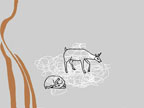
Transgressing Rationality and Efficiency
The Project for Urban Intimacy--by Krista Connerly--offers projects that transgress and counter the rationality and efficiency that infect our cities. Many of these projects seek to alter your daily encounters: moving them past the brief, efficient, and cordial towards the poetic, delayed, or absurd.
The Urban Parlour Games are a set of updated Victorian parlour games. Like the original games they are based off of (and for the most part - carry the same name as) they encourage more intimate forms of interaction. From the Urban Games website you are able to download materials that will let you take these games "to the streets".
Transitory Contact is a collective representation of the intercourse and exchange that takes place, often unnoticed, as we travel innocently to and from work. This piece uses the internet to gather and distribute these stories of contact in order to create a growing collective map. On the website, the user scrolls over a different city area bus maps to read about the encounters that took place along the corresponding bus lines. Additionally, the user is encouraged to deposit their own accounts on the web site so that they can become part of this collective document. The end result is the creation of a secret social map that can be laid over our everyday physical one.
Sleep is a viewer built performance using one's self and a sleeping computer. Your computer accompanies you as you drift off to sleep. Its noises intermix with yours, lulling you and sending transmissions to you.
Solfataras is an on-line collaborative play. Scenes are proposed through photos, a printed manual, and user input to a website. Participants may go online to view instructions and meeting times and places left by myself or other participants. Likewise, there is an on-line forum for individuals to create their own scenes. These can be acted out independently or be extended as invitations to myself and others. [blogged on stunned]
Posted by jo at 01:01 PM | Comments (0)
Girls Ambient Room
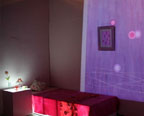
Quiet Please!
Girls Ambient Room uses sound, music, animation & light projections to visualize information at the periphery of human perception by subtly & artfully displaying personal communication data. The room was specially designed for Taiwan teenage girls, reflecting their aesthetic, their taste, & their values.
data is gathered from different chat services, email & comment entries to their personal online journals. when the user (the Taiwan teenager) is in her room & receives a message on MSN chat, she hears audio signals that are in tune with one another, & sees bubble-like visual animations are created on the wall. Email traffic is represented by lines on the screen which start to animate & vibrate. the more email the more vigerous the animations. [blogged on information aesthetics]
Posted by jo at 12:42 PM | Comments (0)
SenToy
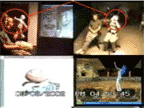
Tangibility in Gameplay
"ABSTRACT: In this paper, we describe a way of controlling the emotional states of a synthetic character in a game (FantasyA) through a tangible interface named SenToy. SenToy is a doll with sensors in the arms, legs and body, allowing the user to influence the emotions of her character in the game. The user performs gestures and movements with SenToy, which are picked up by the sensors and interpreted according to a scheme found through an intial Wizard of Oz study. Different gestures are used to express each of the following emotions: anger, fear, happiness, surprise, sadness and gloating. Depending on the expressed emotion, the synthetic character in FantasyA will, in turn, perform different actions. The evaluation of SenToy acting as the interface to the computer game FantasyA has shown that users were able to express most of the desired emotions to influence the synthetic characters, and that overall, players, especially children, really liked the doll as an interface." From Towards Tangibility in Gameplay: Building a Tangible Affective Interface for a Computer Game [pdf] by Ana Paiva, Rui Prada, Ricardo Chaves, Marco Vala, Adrian Bullock, Gerd Andersson, and Kristina Hook.
Posted by jo at 12:21 PM | Comments (0)
UpStage
![]()
Open Walk-Through
The next open walk-through in UpStage is taking place this Wednesday, December 7, at: California, USA: 12am; New York, USA: 3am; UK: 8am; Western Europe: 9am; Finland: 10am; Australia - NSW: 7pm; NZ: 9pm. Check here or here for your local time.
We'll be meeting on the Introduction stage, audience members can come directly to: http://upstage.org.nz:8081/stages/presentation/. If you want to participate as a player, email me for a log in--helen[at]creative-catalyst.com
Posted by jo at 12:06 PM | Comments (0)
New on Audiohyperspace
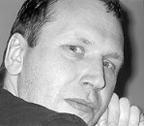
"free lutz!" by Johannes Auer
Dec 8, 2005, 7 p.m. CET, Berlin: FM 95.2 - Wroclaw/Poland: FM 91.3
The stochastic texts by the German mathematician Theo Lutz from the year 1959 are considered being among the milestones of computer-generated poetry. Stochastic texts are texts whose words are defined by chance. Sentences ort parts of sentences are selected by chance operations and are put together to form a language continuum. The free lutz! radio project by Johannes Auer, one Germany's best-known net artists, is based on reprogramming the original pioneering work. A web interface allows listeners to influence the generation of text both at the gallery and on the Internet. The listeners can participate in generating the text, done by the machine, via a web interface. Together with the computer, the listeners will create the textual basis of the live program, during which a speaker will "stage" in real time the computer poetry. Text input is possible in German and Polish.
http://auer.netzliteratur.net/copernicus/ http://www.swr.de/swr2/audiohyperspace/engl_version/interview/auer.html
Also New on Audiohyperspace
Posted by jo at 11:53 AM | Comments (0)
Carnevale 3.0

A Database of Lived Experience
In Carnevale 3.0--by Reva Stone--a life-sized, double aluminum cutout surrogate of the artist as a young girl moves through the gallery space on a robotic platform. Sandwiched between two identical cutouts are a small video camera and a small video projector. As visitors enter the gallery space, the figure interacts with them by turning and moving toward them. At random intervals, their image and movement is video captured. These images are combined and overlaid with previously stored images and projected outward from its metal body through the small video projector. Carnevale 3.0 carries images from each of its venues to the next, building a database of lived experience in which the captured video images become memories of the original event. As a mediator of experience this robotic entity has the ability to manifest human behavior by generating responsive movements, processing information, and accessing long term or short term memory. Recollection, physicality and sentience become mutable entities. [via Rhizome]
Biography
Reva Stone is a Canadian artist who creates computer-assisted installations that have engaged with a variety of forms of emerging technologies—interactive installation, robotics and most recently responsive 3D environments. She explores issues surrounding technology’s augmentation and alteration of the human body by creating works that seem to mutate, evolve, and respond with a life of their own.
Stone’s work has been exhibited at the Walter Phillips Gallery at the Banff Centre for the Arts, Banff, Alberta: Musée d’art contemporain in Montréal, Québec: the Canadian Museum of Contemporary Photography, Ottawa, Ontario: La Chambre Blanche, Québec City, Québec: The Winnipeg Art Gallery, Winnipeg, Manitoba: Gallery 44, Toronto, Ontario: the Mackenzie Art Gallery, Regina, Saskatchewan: the Dunlop Art Gallery, Regina, Saskatchewan and the Musée Régional de Rimouski, Rimouski, Québec. In 2001, Stone co-edited an anthology titled The Multiple and Mutable Subject published by the St. Norbert Arts Centre, St. Norbert, Manitoba. In 2002, her robotic work, Carnevale 3.0 received an honourable mention from Life 5.0, Art & Artificial Life International Competition, Fundación Telefónica, Madrid, Spain.
Posted by jo at 11:45 AM | Comments (0)
ReTag
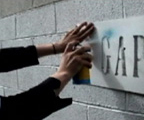
Retroactive Logo Distribution
The 'brand', i.e. the corporate identity symbolized by the logo, is the visual capital of the corporation and their precise and prudent strategy is to cautiously distribute it through our visual scanning space. ReTag is a project hosted on the Conglomco collective's server and it proposes a tactic for boycotting some brands through an indiscriminate multiplication of the logo's presence that would saturate our tolerance for repetitive advertisement. To contribute to this task some logos are available to download, and then they'd printed and transformed in stencils, and then spray them in the most familiar places, making a very bad impression, as if the same brands have crossed the line. Even if the project is at an embryonal level compared to a very different work as NikeGround, it uses the same strategy: pushing the as far as possible the so-called 'brand awareness', aiming at transforming it in a tedious and excessively untimely presence. [via ]
Posted by jo at 10:53 AM | Comments (0)
December 02, 2005
Vodafone’s Receiver, Issue 14
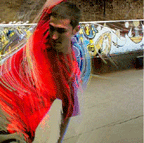
Dynamically Connected: So What?
Mobile services are constantly breaching new boundaries, and will have an enormous impact on the logistics of life – both in terms of productivity and social networking. But the one most important basic feature will always be the ability to dynamically connect everybody with everybody else. So the question is: What do we want to bring together, exchange or take with us, and how can we do this when we're out in the field? This time around, Receiver levels a look at applicability issues – how can we work, learn, cooperate and know better using mobiles?--Articles:
Mark Pesce:
Understanding networks- using devices kids love for their education; Jonathan Donner: User-led innovations in mobile use in sub-saharan Africa; Marc Prensky: Mobile phone imaginationon
James Katz: The future of a futuristic device; Mark Lowenstein: The next generation of usability - re-thinking the mobile device; Nathan Eagle and Alex (Sandy) Pentland: Organizational rhythms - the search for the patterns of the aggregate; Lars Erik Holmquist: The mobile user experience - how boundaries between devices are starting to disappear ; Sara Price and Yvonne Rogers: Designing new learning experiences with pervasive technologies; Jeff Pierce: Serendipitous sharing through personal information environments
Posted by jo at 05:25 PM | Comments (0)
VirtuSphere
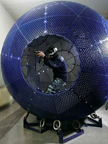
Move Freely in a Fully Immersive Environment
VirtuSphere revolutionizes the way humans interact with computers. The method and system provide infinite space and the most immersive experience for simulated training, exercise and gaming.
The VirtuSphere platform consists of a large hollow sphere that sits on top of a base and allows the sphere to rotate 360 degrees. Wearing a wireless, head-mounted display, users can step inside the sphere to fully interact in immersive virtual environments. The VirtuSphere enables 6 degrees of freedom – one can move in any direction; walk, jump, roll, crawl, run over virtually unlimited distances without encountering real-world physical obstacles.
VirtuSphere systems are made to client specifications and typically include an easy-to-assemble sphere, a base platform that enables it to rotate, a head-mounted display, 3D sensors, sphere rotation trackers, a computer, device drivers and 3D software applications. [via Rhizome]
Posted by jo at 11:19 AM | Comments (0)
Virtual Air Guitar
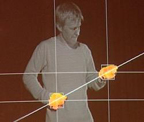
Air guitarists’ rock dreams come true
"Aspiring rock gods can at last create their own guitar solos - without ever having to pick up a real instrument, thanks to a group of Finnish computer science students. The Virtual Air Guitar project, developed at the Helsinki University of Technology, adds genuine electric guitar sounds to the passionately played air guitar.
Using a computer to monitor the hand movements of a "player", the system adds riffs and licks to match frantic mid-air finger work. By responding instantly to a wide variety of gestures it promises to turn even the least musically gifted air guitarist to a virtual fret board virtuoso.
Aki Kanerva, Juha Laitinen and Teemu Mäki-Patola came up with the idea after being invited to develop a virtual instrument as part of their coursework. "The first thing that came to mind was an air guitar," Kanerva told New Scientist. The resulting system consists of a video camera and a computer hooked up to an appropriately loud set of speakers. A player then needs only to don a pair of brightly coloured gloves in order to rock out. Computer vision software automatically keeps track of their hands and detects different gestures, as a video of the system in action demonstrates (22MB, requires Windows Media Player and DivX codec for the visual aspect of the footage)..." Continue reading Air guitarists’ rock dreams come true by Will Knight, NewScientist.com news service, November 2005. [via Eyeteeth]
Posted by jo at 09:20 AM | Comments (0)
RealMan
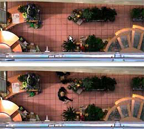
Surveillance Reality Manipulator
RealMan, the Surveillance Reality Manipulator, explores the notions of authenticity and effectiveness of surveillance and its ubiquitous presence in modern society. The video installation consists of a MIDI control keyboard and an image display. The user plays the keys and manipulates in real-time the surveillance space, choosing who and what can be seen at will.
The scene can be composed and the activities of ‘real’ people in the space can be directed with the simple application of a piano key. Each keyboard key triggers a particular video clip to be superimposed into the space. These clips are ‘sprites’, unique characters extracted from the surveilled space and layered onto the background.
This experience is designed to forcefully translate the voyeuristic all-seeing eyes of the camera onto those of the viewer and to illustrate the imprecision of the reality filtered through a technological medium. More details in the PDF. By Greg Judelman. Also by the artist: the Company Keeper. [blogged by Regine on we-make-money-not-art]
Posted by jo at 08:50 AM | Comments (0)
Neon Racer
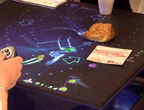
Real and Virtual Worlds Collide
Neon Racer is a multi-user Augmented Reality racing game on an AR tabletop setting. The game displays only the players’ racing vehicles and the checkpoints. The active setting for the game is provided by the physical world, and all its parts can influence gameplay. Physical objects act as collision obstacles and influence the course of the race itself. Participants have to interact with both the virtual and real objects to succeed.
The position and edges of physical objects are detected using a camera and natural feature tracking. Players have to maneuver their vehicles past these objects and through the checkpoints.
Developed by Markus Weilguny, Doris Bernert, Wolfgang Litzlbauer, Ines Stuppacher and Manuela Waldner. [blogged by Regine on we-make-money-not-art]
Posted by jo at 08:48 AM | Comments (0)
The Lunatics

Audience Animation
The Lunatics is an interactive experience that guides you through the Lunatics tribe’s transformative journey from being consumers to becoming creators. The Lunatics have always worshiped the moon, but during more precarious times, they ignored it in favour of a more consuming light. They wanted more, more, more; and their cherished moon slipped away. One day, a Lunatic realized that living without the moon was no way to be and set off, with you by his side, to bring it back.
This 6.5 minute animated fairytale is presented using a new form of participatory theater, which blends the role of audience and participant. While wearing masks, you are transported onto the screen and into the story where you see, hear and physically engage with the tale’s themes. Your outlines are projected onto a movie screen and your movements trigger animations that affect the world on the screen. Images and Video.
Canadian Film Centre's Habitat New Media Lab Alumni, Warren Brown, Louise Charlebois, Kirstin Hargie and composer Adam Goddard are set to install The Lunatics at the Emmersive Gallery in Toronto; exhibiting from December 1 to 11. [blogged by Regine on we-make-money-not-artt]
Posted by jo at 08:38 AM | Comments (0)
December 01, 2005
Street Games
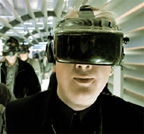
Bluring the Boundary Between Gaming and Reality
"At the same time as people are diving into game worlds, the games are starting to invade the real world. You're moving through the streets of Melbourne stalking your quarry. A phone call on your GPS mobile phone tells you your target is only a few streets away. A direct kill means boosting your team's score. And in this game, winning is everything. Welcome to the world of "real-life" games that blur the boundary between gaming and reality.
Last year the classic arcade game Pacman came to life on the streets of New York. A player dressed as Pacman ran around Manhattan collecting virtual "dots" while trying to evade four players dressed as ghosts. Each player had a human controller back at base who monitored their progress online and phoned through strategy and advice.
A few months later, a lab at Singapore National University had developed a version of the same game using GPS and motion sensors to track players through the city's streets. This time, players could see the game overlaid on the real world through special goggles called augmented-reality headsets." Continue reading Street games by Fran Molloy, The Sydney Morning Herald.
Posted by jo at 01:44 PM | Comments (0)
Paul Geluso
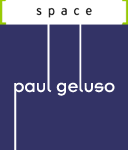
Homage to a Site
New York based sound artist and composer Paul Geluso creates a site specific multichannel installation with seemingly abstract processed sounds, devoid of recognisable musical form. Each channel plays sound textures at different lengths; as time goes by the relationship between the sounds drifts apart, inviting the site’s ambient sounds into the ephemeral moment. The familiar and the unknown are infinitely juxtaposed.
A sound narrative takes form through sampled sounds from the site, relating to its past and present, its regeneration and transition. Sensations of the site’s unique spatial dimensions and appearance are heightened and while walking around defining the sounds, the participants create their own individual soundscape, their personal mix. Scenes change as inner spaces and memories are discovered.
Homage to a Site, 2005 by Paul Geluso; A newly commissioned site-specific multichannel sound installation; Curated by Berit Fischer. 1 December 2005 – 7 January 2006; Private View Wednesday 30 November, 6-8pm; Open: Wed-Sat, 1-6pm or by appointment
SPACE, 129-131 Mare Street, London E8 3RH; Tel 020 8525 4330 Bus: 26,48 from Liverpool St,106 & 254 from Bethnal Green, 55 from Old St.; Tube: Bethnal Green Train: Hackney Central Silverlink
RESONANCE 104.4 FM Broadcast: Thursday 1 December, 4.45pm.
ABOUT Paul Geluso
Paul Geluso achieved his Master Degree in Music at the New York University. Since 1999 he has been composing electro-acoustic music and sound scores for j mandle performance, a New York based experimental arts organisation that creates site specific performances in unexpected locations with the intention to heighten the public’s perception of its everyday environment. His electronic music compositions have been presented at major institutions in New York City including The New Museum of Contemporary Art, Cooper- Hewitt School of Design, The Storefront for Art and Architecture and Gale Gates Et Al.
Geluso is a full time lecturer of audio art at New York University and State University of New York at Oneonta. As audio engineer he has worked at Harvestworks Digital Media Arts with artists like Vito Acconci, Marina Rosenfeld, Christian Marclay, Phil Niblock, Stephen Vitiello who use sound in their creative work. He has mastered and mixed award winning films and performed on many albums. Recent awards include the individual artist grant in composition from New York State Council on the Arts, the John E. Robinson Foundation and Meet the Composer.
Homage to a Site will be his first solo show in the UK.
For further information please contact Berit Fischer: :beritf[at]excite.com Tel: 079 3179 3315
Posted by jo at 12:53 PM | Comments (0)
A Performance Lecture by Walid Raad
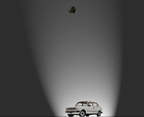
My Neck is Thinner Than a Hair
On December 6, Walid Raad will present a one-hour performance lecture, "My Neck Is Thinner Than a Hair: A History of the Car Bomb in the 1975-1991 Lebanese Civil Wars, Volume 1: January 21, 1986." [Webcast] It is the result of his year-long collaboration with artists Tony Chakar and Bilal Khbeiz. This particular piece examines a single car bomb detonated January 21, 1986 in the Furn Ech Chubak area of Beirut. But their ongoing collective work considers the many vexed dimensions—social, psychological, political, economic—of war-torn Lebanon. Indeed, it investigates the complex responses to the 3,600 car bombs that exploded between 1975 and 1991. The project is co-produced by The Atlas Group (Beirut/New York), Ashkal Alwan (Beirut), Kunsten Festival des Arts (Brussels), House of World Cultures (Berlin), Spectacles Vivants, Centre Pompidou (Paris), and the Vera List Center for Art and Politics at The New School. [Webcast]
Born in Lebanon but now residing in the United States, Walid Raad is one of the most significant new voices in visual arts and culture. His works include video, photography and literary essays. Focusing on specific incidents of car bombings in the contemporary history of Lebanon, Raad investigates traumatic events of huge proportion, and the ways film, video, and photography document trauma and violence. In our current climate of cultural and political polarization, his work resonates deeply. For it shows how the visual and performing arts contribute to our increased understanding of the Middle East.
His first solo exhibition in New York, “The Dead Weight of a Quarrel Hangs,” will open January 7, 2006 at The Kitchen in Chelsea.
The New School, Tishman Auditorium, 66 West 12th Street, First Floor. Tuesday, December 6, 8 p.m.; $8. Free for Students with Valid ID. Tickets can be purchased by phone with a credit card (212) 229-5488 or in person at The New School Box Office, 66 West 12th Street, main floor, Monday-Thursday 1-8 p.m., Friday 1-7 p.m. Reservations can be made by email: boxoffice[at]newschool.edu.
Founded in 1992, The Vera List Center for Art and Politics embodies The New School’s historic commitment to the arts. The center organizes and sponsors public events, online programs, and occasional publications. It engages cultural production that emerges inside and outside the traditional art world and seeks to intervene in contemporary political debates. A place where scholarship develops into general resource, policy, and civic engagement, the center reaches both national and international audiences.
CONTACT: Daniel Morris. 212.229.5485 x 3094. morrd109[at]newschool.edu
Deborah Kirschner. 212.229.5667 x4310. kirschnd[at]newschool.edu
Posted by jo at 12:27 PM | Comments (0)
DIGITAL STREET CORNER
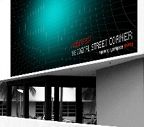
Virtual Street Corner Happening
DIGITAL STREET CORNER by Fred Forest; Art Basel Miami Beach 2005: Is it possible to surf around in cyberspace and hang out on the street corner at same time (global + local = glocal)? French artist Fred Forest will show us how at a world premiere event that will take place November 30-December 4 in the prestigious context of Art Basel Miami Beach 2005. Forest invites the Internet users of the world to meet him down in the street outside the Bass Museum of Art in Miami Beach for a memorable cyber-happening. There's no need to reserve a plane ticket because the setting will actually be a "corner" of virtual reality, specially created with the help of a new open source peer-to-peer software program developed by Joachin Keller Gonzalez of France Télécom R&D. On the dates indicated, Forest aims to make art history by creating a unique real-time digital work of art with the help of online participants near and far. This work will consummate the official (esthetic and economic) recognition of a new model of art whose content and format bear no comparison to those of the past, an art for the wired societies of the information age.
Forest is no neophyte in the field of new media. He is widely recognized as a pioneer of video art in Europe and co-founded two major avant-garde movements with a focus on interactive media hybrids, Sociological Art and the Esthetics of Communication. In reference to his hacker-like tactics, Vilem Flusser called him "the artist who pokes holes in the media." Forest is also a Net Art pioneer. He won the City of Locarno Grand Prize at the Locarno Festival of Electronic Art in 1995 for his work "From Casablanca to Locarno." People are still talking about his virtual reality-enhanced "Cyber-marriage," which took place live online in 1999 (his best man was none other than the "father of the Internet," Vinton Cerf).
The DIGITAL STREET CORNER Web site, will open on November 20, 2005 in order to give members of the public a chance to upload their free "ticket" to Miami Beach and carve out their very own niche in cyberspace. Don't miss your chance to strut your stuff in Miami Beach in the company of your new digital friends. A wealthy art collector from the world of high finance has already paid a fortune to be the first in line!
On November 30, 2005, a special cyber-happening is scheduled to take place at "THE DIGITAL STREET CORNER" between 9 PM and 11 PM (local time). Forest himself will be the DJ, at the commands of his four computers, his console, and his turntable. To participate in the happening, visit http://www.fredforest.com
Everything that happens at "THE DIGITAL STREET CORNER" will be projected live onto the exterior walls of the Bass Museum in Miami Beach throughout the four-day duration of the event. And the festivities of the cyber-happening will be webcasted live for millions to see on the "DIGITAL STREET CORNER" Web site. Don't miss your chance to meet and party with people from around the world on this virtual street corner, located for a short time only in "real" space at 2121 Park Avenue in Miami Beach. Project Sponsors:France Télécom, Bass Museum, Cartier Foundation for Contemporary Art, Cultural Service of the French Embassy in New York, French Consulate General in Miami, webnetmuseum.org
Posted by jo at 12:10 PM | Comments (0)
Gameplay
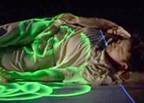
the dance body-machine relationship
From such a long time a dance and the electronic technologies have found a good connection, mostly in the use of motion sensors. These devices allowed the body to expand its movements beyond themselves, giving the body itself a role of a crucial node to external events, kinetically connected. But the sensors has become a simple short cut, humiliating the research for new interaction criteria between the organic dynamism and the electronic reaction speed. Gameplay by Antoine Schmitt, Jean-Marc Matos and Anne Holst is a project that tries to bring the language of early videogames in a choreography finding its link in both the domains' concept of physical test. The interaction between the performer's body and the illuminated forms that skim over it are emanating an affective aura. It's an interaction that reminds more the interaction fluidity of the organic forms than the univocal sensor's reactions. So a different dance grammar is compiled, enriched with new forms. These forms that set up a fluid symbiosis with the artificial light emitted in the body-machine relationship. [via neural.it]
Posted by jo at 11:49 AM | Comments (0)
Calling for informations

Art Calling-Digital Art Stories
Chiara Passa is developping for Medialab in Madrid a project called Art Calling-Digital Art Stories.The purpose of the project is to bring people closer to digital art in an easy way. “Art Calling-Digital Stories” is a public art project that invites people to listen to stories about digital art (through phone booths used as a communicative medium).
People using “Art Calling-Digital Stories” only need to dial a telephone number (listed on sticker on the booth) which is linked to a switchboard (from a telephone company) with various vocal options and also various audio files. For instance, one of the audio files could be about software art and it will correspond to the phone’s #5 key. The person wanting to listen to information on software art, must call the number, hear all the vocal options and later push button #5. Inside the booth people will find another sticker with instructions about how to connect with different stories. Every tale will be told in English. The stories are about the most interesting artists, artworks and events on interactive art, software art, modified video games, demo scene, hacking tools, digital animation, video installation, sound art, from the beginning to present day, several selected by Passa herself.
The “Art Calling-Digital Stories” audio files will also contain additional materials such as bibliography, webography, info about artists, specific projects, festivals and various resources.
Submissions regarding artistic material and artist’s works can be sent to chiapa@libero.it
Art Calling-Digital Art Stories
2005
Chiara Passa
Posted by luis at 07:20 AM | Comments (0) | TrackBack

